Linda Stratmann is the author of the Mina Scarletti Mysteries and the Early Casebook of Sherlock Holmes series.

There are many different interpretations of Sherlock Holmes created by authors inspired by the works of Conan Doyle. They might sometimes appear to conflict, but it was my love of science fiction that made me realise that the different versions can all be valid at the same time if they exist in parallel universes. One such interpretation is that Holmes is not human but alien, or possibly even an android.
The Holmes in my books is a human, if an unusual one, but can a good case be made for him not being human? The basis of the case must, I believe, be derived from what I call ‘the canon’ — the original Holmes fiction of Conan Doyle.
So let us examine the canon and look for the clues.
Our first evidence is from Dr Watson himself. In an uncharacteristic feat of observation in The Sign of Four, he declares, ‘“You really are an automaton, — a calculating machine. […] There is something positively inhuman in you at times.”’ Holmes, he says in ‘A Scandal in Bohemia’, is ‘the most perfect reasoning and observing machine the world has seen.’
But what other clues do we have? There are many.
Clue one: An alien or android has no family tree, and Holmes is extremely cagey about his ancestors.
In ‘The Greek Interpreter’, Watson states that Holmes’s gifts for observation and deduction must come from his systematic training, and not his ancestry. Holmes agrees that this is true to some extent and reveals that his ancestors, who he does not name, were country squires who led the life ‘“natural to their class”’. However, he attributes his powers of observation to descent from a family of French artists. His grandmother was the sister of the French artist Vernet. There must, he believes, be some hereditary principle, as his brother Mycroft has the same talent.
If Holmes was an alien or android, a vague reference to unnamed county squires and an artist whose family connections could not have been easily researched would have satisfied Watson’s curiosity. Watson saw some similarities between Holmes and Mycroft, and if Holmes was an alien or android, it would suggest that Mycroft was as well.
Clue two: Holmes has strangely superhuman strength.
Holmes is not a burly man. In ‘The Red-Headed League’, ‘He curled himself up in his chair, with his thin knees drawn up to his hawk -like nose.’ Yet he obviously had a sinewy strength and was skilled in boxing, singlestick and swordsmanship.
To maintain bodily fitness over many years, regular exercise is usually necessary, but with Holmes this is not the case. ‘I have a curious constitution,’ he says in The Sign of Four. ‘I never remember feeling tired by work, though idleness exhausts me completely.’ He then heads off for a smoke.
In ‘The Adventure of the Speckled Band’we have this extraordinary incident. Holmes receives a visit from tall, broad and fierce Dr Grimesby Roylott. Roylott tries to intimidate Holmes by picking up a steel poker and bending it into a curve before flinging it down. After his departure, Holmes picks up the poker ‘and with a sudden effort, straightened it out again.’ Is that even humanly possible?
In ‘The Adventure of the Yellow Face’, Watson tells us that Holmes ‘seldom took exercise for exercise’s sake’ and that he regarded ‘aimless exertion’ as ‘a waste of energy’. Yet he also tells us that ‘Few men were capable of greater muscular effort’ and Holmes was ‘one of the finest boxers of his weight that I have ever seen.’ When there was a requirement for action, he was ‘untiring’. By the time this story was published in 1893, Conan Doyle might have sensed that he needed to explain to his readers the anomaly of a man who hardly ever exercised but excelled at physical activity. ‘That he should have kept himself in training under such circumstances is remarkable,’ says Watson, who goes on to say unconvincingly that ‘his diet was usually of the sparest and his habits were simple to the verge of austerity.’ Holmes, he adds, ‘save for the occasional use of cocaine […] had no vices.’
Clue three: Holmes uses drugs and smokes, apparently without adverse effects.
Conan Doyle introduces us to Holmes’s use of cocaine in The Sign of Four, which includes a brief single reference to the recreational use of morphine. (It is only ever used once again by Holmes, given medicinally in ‘The Adventure of the Illustrious Client’). In ‘The Adventure of the Yellow Face’,published three years after The Sign of Four,ConanDoyle obviously feels the need to dial back, perhaps after some disapproval expressed by his readers, and tells us that ‘he only turned to the drug as a protest against the monotony of existence, when cases were scanty and the papers uninteresting.’ Holmes’s heavy smoking of strong tobacco is never seen by Watson as a vice, or as something that might affect Holmes’s health.
There are numerous references in the stories to Holmes smoking heavily. In ‘The Man with the Twisted Lip’, Holmes smokes an ounce of shag tobacco while deliberating, leaving his room ‘full of a dense tobacco haze.’ In ‘The Adventure of the Engineer’s Thumb’,his before-breakfast pipe is ‘composed of all the plugs and dottles left from his smokes of the day before, all carefully dried and collected on the corner of the mantelpiece.’ If Holmes is an alien or a machine, that explains his apparent imperviousness to the harmful effects of drugs and tobacco. In later adventures, Conan Doyle does however make him more believable by showing Holmes exhausted by his burden of work as he ages. The last year in which a Holmes story is set is 1914 (His Last Bow, published in 1917), by which time he is sixty years of age, and to Watson’s eyes, has hardly changed.
Clue four: Holmes shows little emotion.
Science fiction readers and writers have compared Holmes to an android like Star Trek’s Data, lacking emotion of any kind. If he is an alien, he most closely resembles Star Trek’s coolly logical Vulcans. They have emotions but restrain them; however, they are obliged to let them all out once every seven years in a ritual called pon farr. Does this fit with Holmes’s behaviour? Does a restriction of emotions cause Holmes any stress? If he was a Vulcan, like Mr Spock, could this explain what was really happening in 1891 when Holmes rushed away to the Reichenbach Falls and did not return for three years? Did he feel the approach of pon farr and have to quit England before it took him over? If so, there would be other absences at similar intervals.
I counted back seven years and then I saw it. There are no adventures chronicled by Watson for the years 1884 and 1885. Was this because of a previous pon farr? Holmesian scholars have assumed that during these years Watson was away, perhaps in America, but there might be another explanation? Was Watson with Holmes during these absences, his account carefully crafted to conceal the truth about his friend? Looking ahead another seven years from 1892, there are no adventures dated from between January 1899 (‘The Adventure of Charles Augustus Milverton’) and June 1900 (‘The Adventure of the Six Napoleons’). There are no adventures dated 1906, or 1913. This is all supposition, of course, but the timeline is compelling.
Clue five: Holmes does not wish to marry.
Not only is Holmes averse to marriage, he appears to have no romantic or intimate connections with anyone. If he is not human, this is something he would avoid, or his masquerade as a human might be discovered. Conan Doyle is careful to avoid any suggestion of Holmes having hidden desires which would have alienated his readers. According to Watson, Holmes’s only such interest, is a woman, ‘the woman’, as he calls her, Irene Adler, whom he clearly admires but without allowing any emotions to disturb his finely balanced mind.
On what principles was the alien or android Holmes constructed or programmed?
If Holmes was sent to Earth programmed to solve crimes, he needed to be constructed from many parts. Superhuman strength and constitution. Numerous useful skills. Impervious to the ravages of smoke and drugs. A brilliant reasoning machine undistracted by emotions. The aliens who made or trained him would have studied other detectives of the era and used elements of the finest to create Holmes.
There are three main candidates:
Joseph Bell (1837–1911) was a Scottish surgeon and lecturer who advocated the importance of careful observation. Conan Doyle was a student of Bell from 1877 to 1878. Bell used his observational talents to deduce personal details about complete strangers, a skill which Holmes frequently employed.
Edgar Allan Poe’s C. Auguste Dupin is considered to be the first fictional detective, who used advanced reasoning to solve mysteries. Through observation, he is able to follow the train of thought of his companion, an ability with which Holmes astonishes Watson in ‘The Adventure of the Cardboard Box’.
Le Chevalier Lecoq, a fictional French policeman, inspired by a real criminal investigator, Eugène-François Vidocq (1775–1857). In the works of Émile Gaboriau, published in 1869, Lecoq’s methods when making a detailed examination of a crime scene, using a magnifying glass, are strongly reminiscent of Holmes’s scientific approach. In A Study in Scarlet, Holmes dismisses Dupin as ‘a very inferior fellow’ and Lecoq as ‘a miserable bungler’.
My case is complete. I have laid the facts before you. Make of them what you will.
NOTE:
There were several artists in the Vernet family but only one, Emile Jean Horace (1789-1863) fits the timeline as Holmes’s most probable great uncle. A number of Conan Doyle’s family members were artists, and a friend was a collector of Vernet.
With the forthcoming publication of In Danger’s Hour, the second book in his Romulus Hutchinson Naval Adventure Series, author David Clensy takes a closer look at the events surrounding Operation Excess during the Second World War.
In January 1941, the Mediterranean was a tense theatre of war. The British Royal Navy, stretched thin and under constant threat from Axis forces, launched a bold and complex operation known as Operation Excess. It was a high-stakes convoy mission designed to deliver vital supplies to Malta, Greece and Alexandria, while simultaneously striking a blow against enemy naval and air power in the region.
The convoy itself was a patchwork of merchant vessels and warships, departing from Gibraltar and heading eastward through waters teeming with danger. Malta, then under siege and of immense strategic importance, was a key destination. Supplies were desperately needed to sustain its defences and civilian population. The convoy was escorted by a formidable force of Royal Navy ships, including aircraft carriers, cruisers and destroyers, all tasked with protecting the vulnerable merchantmen from attack.
Operation Excess was a particularly challenging task for the Allied forces. Italian and German aircraft launched repeated assaults, particularly as the ships neared Sicily. The Royal Navy’s carrier-based aircraft, including Fairey Fulmars and Swordfish, fought valiantly to repel the attacks, often flying in difficult conditions and against superior numbers.

One of the most dramatic episodes of the operation occurred on the 10th of January, when HMS Illustrious, a key British aircraft carrier, came under ferocious air attack near Malta. The damage was severe, and casualties were high. Yet the carrier remained afloat and was eventually able to limp into Grand Harbour, where she became a symbol of resilience for the Maltese people.
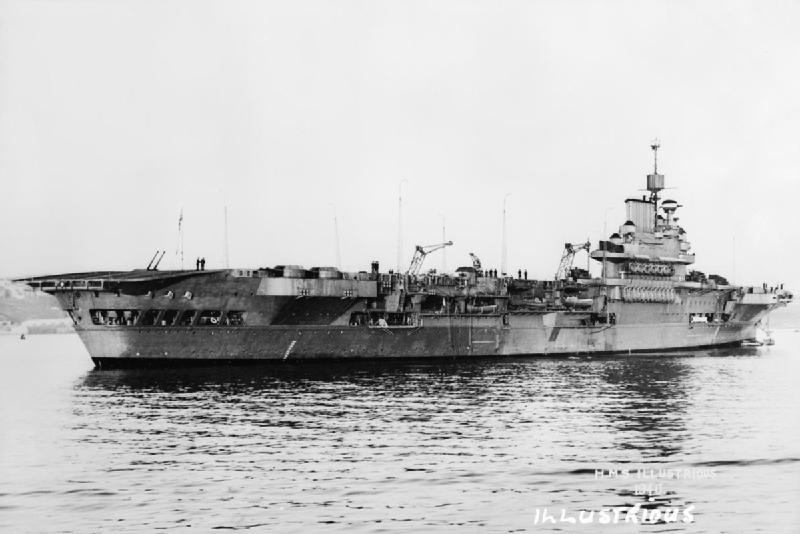
Meanwhile, other elements of the operation were unfolding. British forces used the opportunity to launch diversionary attacks against Italian positions in the Dodecanese and to reinforce troops in Greece.
As part of Force B, HMS Southampton’s role was to transport troops from the Aegean to Malta before joining the main convoy. On the 11th of January, while operating south of Sicily, HMS Southampton came under sustained attack from German dive bombers of the Luftwaffe’s X Fliegerkorps. The Stukas struck with deadly precision, scoring multiple hits that ignited fires and caused catastrophic damage. With the cruiser listing and engulfed in flames, the order was given to abandon ship. HMS Southampton was eventually scuttled by torpedoes from HMS Gloucester to prevent her from falling into enemy hands.
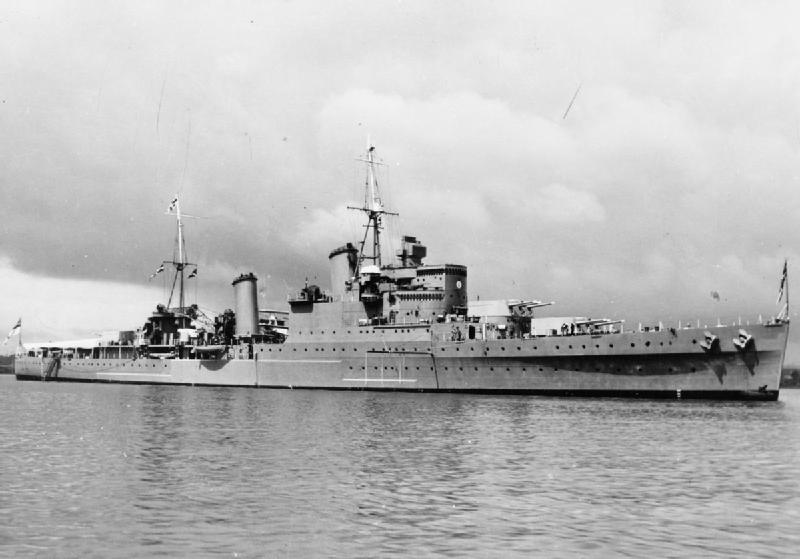
Though the operation came at a cost, it was ultimately deemed a success. Supplies reached their destinations, and the Royal Navy showed it could still operate effectively in contested waters. Operation Excess was more than a supply run. It was a statement of intent, a show of defiance against Axis control of the Mediterranean.
November 2025 sees the release of In Danger’s Hour, the second book in the Romulus Hutchinson Naval Adventure Series. Following their earlier adventures in For Those In Peril, we follow twin brothers Romulus and Remus throughout 1941, from the Mediterranean to the coast of West Africa. It covers a series of key strategic operations, including Operation Demon — the British-led evacuation of Allied forces from mainland Greece in April 1941. At the opening, readers will join our central character, Rom, as he faces an enemy attack while serving on HMS Southampton at the height of Operation Excess.
In Danger’s Hour will be published on the 28th November 2025.
Stay up to date with David’s news and latest releases here.
From Medieval Europe and Georgian England to naval warfare and military autobiographies — there’s something exciting here for everyone. Scroll down to discover this month’s titles from your favourite Sapere authors.
October’s Fiction Releases
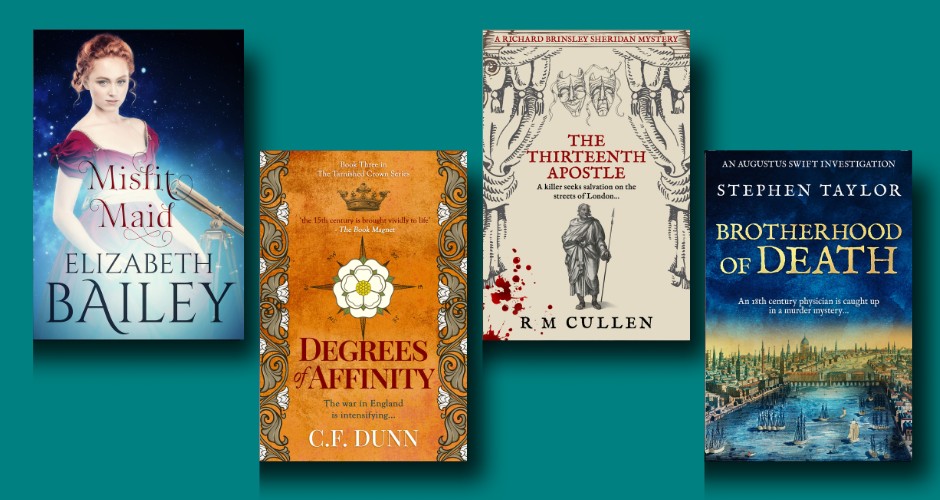
The Misfit Maid by Elizabeth Bailey is a lively, humorous historical romance set in Georgian England with an engaging and unconventional heroine.
Degrees of Affinity by C. F. Dunn is the third book in The Tarnished Crown series: historical fiction set during the Wars of the Roses. Isobel Fenton has overcome her enemies and regained her manor of Beaumancote. Now she looks forward to a future with the man she loves. But when she is unwittingly drawn into the political intrigue at Court, Isobel’s life is once more thrown into turmoil.
The Thirteenth Apostle by R. M. Cullen is the third historical murder investigation in the Richard Brinsley Sheridan Mystery Series: eighteenth-century crime thrillers set in London at a time of Revolution. Can Sheridan unmask a ruthless killer stalking the streets of London?
Brotherhood of Death by Stephen Taylor is the first historical murder investigation in the Augustus Swift Investigations Series, a new detective series set in Georgian England. When a series of cabinet members are poisoned, physician Augustus Swift must employ science and logic to prevent more deaths.
October’s Fiction Backlist Release

We are delighted to announce that the first book in the Robert Porter Alternative History Thrillers is out now! Ultimatum by Richard Rohmer is a heart-pounding political thriller that hits close to home. The fate of millions hangs in the balance when a crisis right out of today’s headlines sets the President of the USA on a course from which there can be no retreat.
October’s Non-Fiction Releases
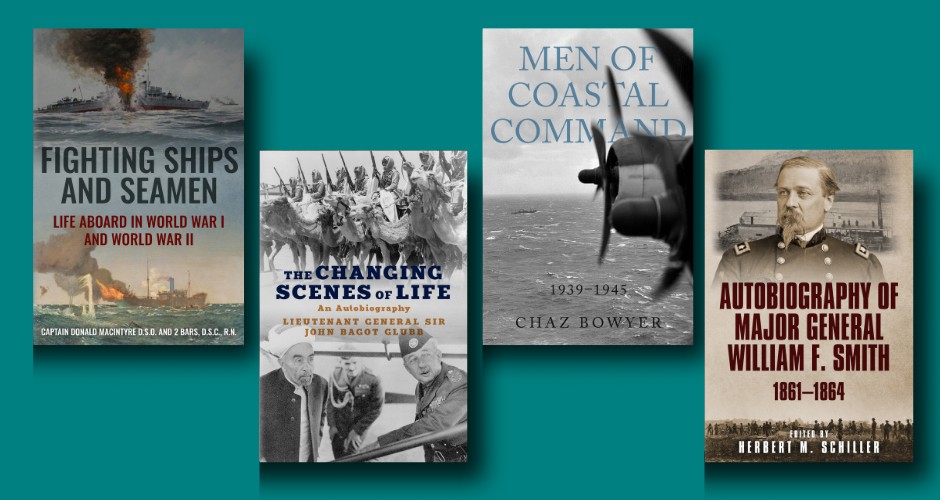
Fighting Ships and Seamen: Life Aboard in World War I and World War II by Donald Macintyre charts the experiences of sailors and their ships during naval engagements and is an essential account of naval warfare across the two world wars.
The Changing Scenes of Life: An Autobiography is a gripping account of the life and legacy of Sir John Bagot Glubb — soldier, scholar, and legendary commander of the Arab Legion.
Men of Coastal Command: 1939-1945 by Chaz Bowyer is an eye-opening account of a much-overlooked branch of the Royal Air Force, who protected Britain’s seas from the air during the Second World War.
Autobiography of Major General William F. Smith: 1861-1864 by Herbert M. Schiller is a candid autobiography of one of the Union’s most controversial generals — praised as a saviour, condemned as a scapegoat.
Happy reading! Team Sapere
C. F. Dunn is the author of The Tarnished Crown Series: Wars of the Roses historical fiction set in Medieval Europe.
“Double, double toil and trouble” — Shakespeare’s famous refrain from Macbeth — remains one of the most recognisable lines in Western literature. When it was first performed in the early seventeenth century, Shakespeare was drawing on a long tradition of folklore and belief that his audience would have immediately understood. Even if some of the finer details escaped them, they knew the framework: witchcraft, prophecy, and the unsettling idea that unseen forces might determine human fate.
Fast forward to the twenty-first century, and many still imagine witches as medieval figures — women ducked, pricked, and burned amid cries of superstition. In truth, the great witch hunts of Europe belong not to the Middle Ages but to the Early Modern period, from the sixteenth century onwards. From a medieval perspective, witchcraft as we now think of it was relatively uncommon. The frenzied persecutions of later centuries would have seemed alien to most people of the fourteenth or fifteenth centuries.
In fifteenth-century English law there was no specific statute making witchcraft a capital offence. The Church regarded it largely as a form of heresy — a spiritual error, not a criminal conspiracy. It was not until the Witchcraft Act of 1542 that England paved the way to criminalise witchcraft as punishable by death. Before then, most cases resulted only in fines, penance, or public admonition.
The meaning of ‘witchcraft’ in the Middle Ages also differed from the later concept. The boundary between magic and medicine was fluid. Healing practices incorporated charms, incantations, astrological timing, and a range of -mancies — divination by fire (pyromancy), by names (onomancy), or by reflections in mirrors or water (scrying). Medieval healers drew on classical learning, Christian devotion, and folk wisdom alike. A prayer could be as powerful as a potion, an amulet as trusted as a relic.
This was not sorcery in the later, sinister sense, but an expression of a worldview in which the divine and natural worlds were deeply intertwined. The medieval cosmos was one in which the supernatural existed alongside the physical — a realm of possibilities where God, angels, and spirits could all play a part in human health and fate.
By the later Middle Ages, however, witchcraft and divination began to intersect with politics. When accusations touched those close to the throne, the implications became far more serious. The Church might have seen such practices as misguided or at worst, heresy; the state viewed them as potentially treasonous.
Terminology was crucial. ‘Witchcraft’ often implied healing or protection and was tolerated to a degree. But necromancy—a form of divinationthat involved summoning the dead to foretell the future — crossed a dangerous line. When divination involved predicting the monarch’s death, it fell under the crime of “compassing or imagining the death of the king”, one of the key clauses of Edward III’s Treason Act of 1352. Necromancy became not only a spiritual threat but a political weapon.
An infamous example is that of Eleanor de Cobham, Duchess of Gloucester. Accused in 1441 of “treasonable necromancy” for attempting to divine the death of Henry VI, she was sentenced to life imprisonment. Her alleged accomplice, Margery Jourdemayne, the Witch of Eye, was convicted of heresy and burned at the stake. Eleanor’s real offence, however, was more political than supernatural: she denied the allegations of necromancy and treason, but admitted to having sought potions to help her conceive a child with her husband, Humphrey, Duke of Gloucester, whose proximity to the line of succession made him many enemies.
Eleanor’s case was not unique. Similar accusations were levelled against Walter Langton, bishop of Coventry and Lichfield in the early fourteenth century, and later against Jacquetta of Luxembourg and her daughter Elizabeth Woodville, queen to Edward IV. Each was a figure of power and influence, close to the throne and a focus for political attack. When an enemy could not be defeated in open conflict, an accusation of sorcery could prove equally effective and more difficult to defend.
In 1477, the Oxford scholar John Stacy, a man with previous form and known as a magnus necromanticus (great sorcerer) and astrologer of repute, was accused of “imagining the king’s death by necromancy.” Under torture he implicated Thomas Burdet, a member of the household of George, Duke of Clarence, brother to King Edward IV. It was perhaps no coincidence Burdet was also a main suspect in the penning and deployment of seditious writings that questioned Edward IV’s legitimacy and his right to rule — as well as that of his heir.
The oft quoted, but unsubstantiated Prophecy of G has also been linked with subversive writings supposedly foretelling that Edward IV’s rule would be followed by someone with a name beginning with G. As Edward’s son and heir was another Edward, the prediction in itself was treasonable.
It might have been an unfortunate coincidence for the hapless duke that his name was George, or perhaps convenient for those who would malign him before — or after — his death. Whether the Prophecy of G was merely apocryphal, the reference to it in later writings nonetheless reflected a common perception that the power of divination could — and did — exist.
When Clarence publicly defended Burdet and questioned the justice of his trial, he drew attention to himself. His criticism of royal authority and his association with alleged necromancers were enough to throw his loyalty to the Crown into question. Nor did Clarence hold back from accusing Edward of using the black arts to “poison his Subgettes, suche as hym pleased”.
Were accusations of witchcraft and necromancy simply cynical tools to eliminate rivals? At times, perhaps, yet they also reflected genuine belief. When Henry VI heard predictions of his own death, he did not dismiss them as nonsense or political machinations; he ordered his astrologers to investigate. To medieval minds, the natural and supernatural were interwoven. The heavens, the body, and the soul were all thought to lie under divine influence — and, by extension, vulnerable to darker forces.
The fear of the dark arts in late medieval England was not born of ignorance but of imagination — the conviction that unseen powers could alter the course of events. To “imagine the king’s death” through necromancy was not simply treasonous speech; it was a symbolic act that might disturb the divinely ordered world. The real danger from divination in the later Middle Ages was not the village healer or the cunning woman, but the whisper of sorcery at the heart of the royal court.
Notes
The question of magic and politics in England during the later medieval period challenges my ability to encapsulate such a myriad and vast subject in so short a blog. For the curious, there are many useful works available, including the few listed below:
Courting Disaster: Astrology at the English Court and University in the Later Middle Ages by Hilary M. Carey, Palgrave Macmillan, 1992
‘Medieval necromancy, the art of controlling demons’ by Sebastià Giralt. View via Sciencia.cat: https://www.sciencia.cat/temes/medieval-necromancy-art-controlling-demons
Magic in the Middle Ages by Richard Kieckhefer, Cambridge University Press, 2021
‘Thomas Burdet of Arrow, MP for Warwickshire in 1455, and the execution of George, duke of Clarence’ by Simon Payling: https://historyofparliament.com/2022/08/02/thomas-burdet/
‘Witch Hunts in Medieval England: The Trial of Walter Langton’ by Kathryn Walton: https://www.medievalists.net/2021/03/witch-hunts-medieval-england/
Magic as a Political Crime in Medieval and Early Modern England by Francis Young, Bloomsbury, 2020
Clare Hawkins was born and brought up in Scotland and now lives in Essex. She is the author of the forthcoming Gothic House Mystery series for Sapere Books.
My earlier life in Scotland is now distanced by more decades than I like to admit, but the country and its history, landscapes and languages have had a powerful influence on my writing. (The books in my forthcoming Gothic House Mystery series all have Scottish settings.) Personal recollections sometimes surface with surprising vividness too. For example, my grandchildren’s excitement at the prospect of trick-or-treating reawakens memories of how we as children celebrated Hallowe’en in the 1950s in the west of Scotland.
The practice of ‘guising’, or dressing as something other than oneself, has existed in Scotland for hundreds of years. It may even be related to the pagan tradition of ‘Samhuinn’, Summer’s End, the transition from summer to winter, when grotesque spirits of the dead roam abroad, intent on mischief. The best protection is to disguise oneself as one of them.
So we children became a fearsome collection of little witches and ghouls in our homemade cardboard masks, witches’ cloaks and hats made of old blackout curtains, with props such as inky pipe-cleaner spiders and lurid papier mâché severed fingers. We visited our neighbours’ houses, armed with torches and high expectations of receiving sweet treats. However, these gifts were not entirely free; some sort of entertainment had to be provided by us, the guisers, in return. Our sheepish, tuneless renditions of such ditties as ‘Donald where’s yer troosers?’ or ‘Ye cannae shove yer granny aff a bus’ were greeted with sympathetic applause and a handful of sweets from the adults, who no doubt had to suppress their laughter after a few drams as their own celebration of Hallowe’en.
Visit Clare’s website to stay up to date with her news and latest releases.
Featured image credit: Photo by Szabó János on Unsplash.
Patrick Larsimont is the author of the Jox McNabb Aviation Thrillers, which follow a fighter pilot through World War Two, and The Brookwood Boys, a paranormal thriller with flashbacks to the lives of deceased soldiers.
In my paranormal military thriller, The Brookwood Boys, ‘Mouse’ Forsyth has watched over Brookwood Cemetery since his death in 1917. For a hundred lonely years, he’s been the caretaker of lost souls, greeting the good, the bad, the damaged, the mad and the sad. Then one day, he is seen and can communicate with the living for the first time. He and his band of fellow soldiers from World War One and World War Two work together to help find a missing living girl. But what was the inspiration for this story and the historical flashbacks about the lives and deaths of the soldiers who are buried here?
My setting is Brookwood Military Cemetery in Surrey, England, the largest in the UK, set within what was once the largest cemetery in Western Europe. Created in the Victorian era, it was destined to hold all of London’s relocated dead and cater for future bodies delivered directly from London Waterloo. It never achieved this goal but is the final resting place of over a quarter of a million souls.
My first interactions with Brookwood began during the COVID-19 lockdowns. It was a quiet place where I could walk and not encounter too many people. I’ve always been fascinated by cemeteries, particularly military ones, and the more I visited, the more I realised the countless rows represented characters in a story — their own, but also our collective one. I thought, in a place like this, there must be ghosts, stranded by trauma and suffering. What if they told their story and together resolved something that happened in the living world?
Those familiar with my stories will know I include real people in my fiction, and there are no shortage of fascinating stories to be told in Brookwood: secrets, scandals, tragedies and horror. Many have made it into the novel and here are a few which you may find interesting.
Hedwig ‘Hattie’ Raithel was a thirty-three-year-old American nurse who died of influenza in 1918, at a time when she could have been caring for patients in a war-weary world struck by Spanish flu. This frustration has kept her spirit here in my story, as a gentle, mother-like spirit to the others gathered here. The parallels between the deadly outbreak that led to the crowded graves at Brookwood back then, and the mass fatalities resulting from the current global pandemic were not lost on me.
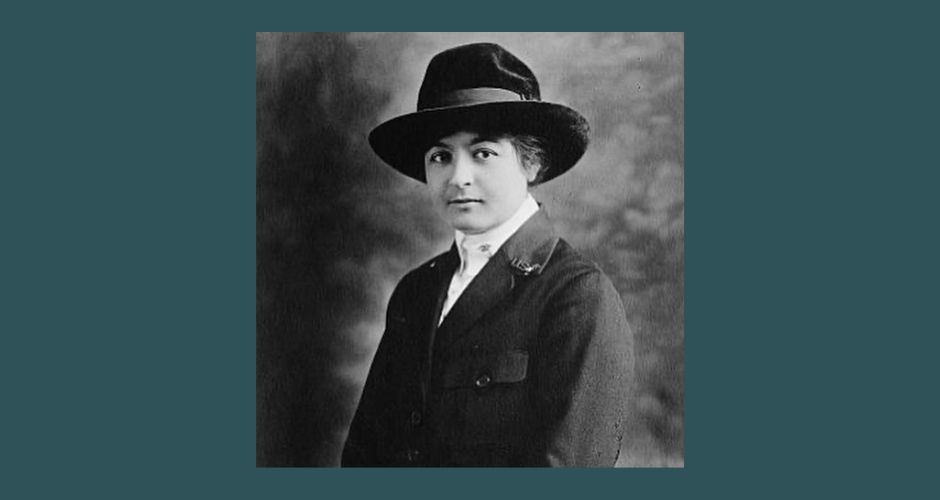
Pilot Officer John B. Ramsay and Sergeant J. ‘Hugh’ M. Ellis couldn’t have been more different in life. Both were fighter pilots during the Battle of Britain, one a public schoolboy from Dorset, the other nicknamed the ‘Cockney Sparrow’ by his squadron mates. Both were just twenty-one, killed within two weeks of each other during the terrible summer of 1940. Both were lost without a trace. It wasn’t until 1983 that Hugh was found and given a full military funeral at Brookwood, followed by John in 1993. They now lie side by side.
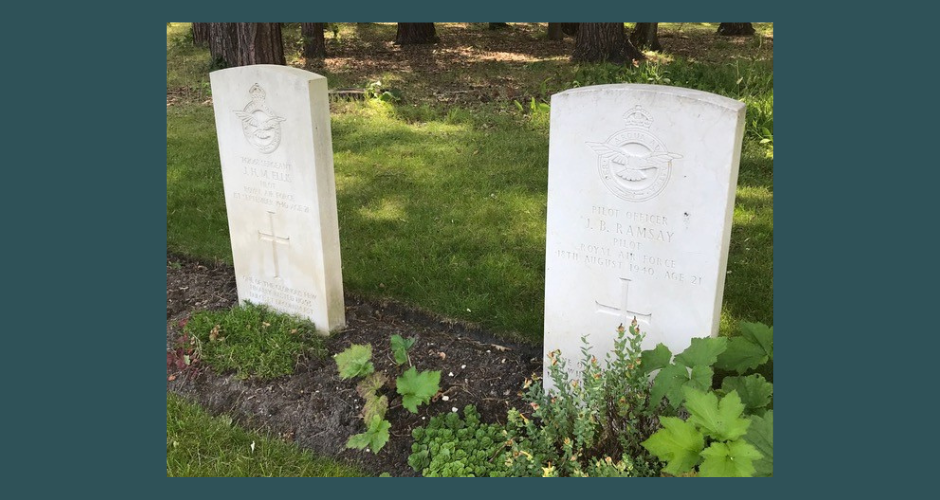
In my story, they become brothers, ‘haunting’ another ghost who might have shot them down. Leutnant Kurt Sidowwas a Luftwaffeace, aged twenty-four, who is also buried at Brookwood with about fifty of his Kameraden. In my story, he is an antagonist, an unrepentant Nazi. But after interacting with John and Hugh, he finds some redemption.
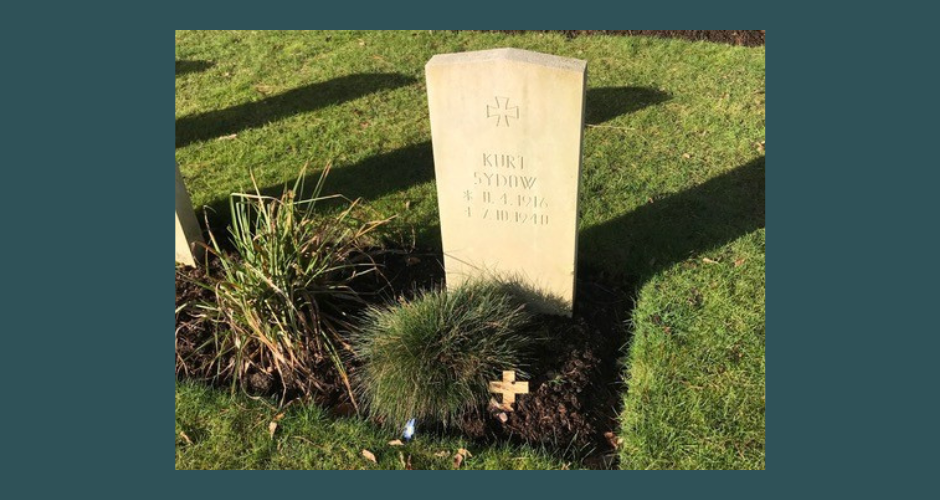
The youngest soldier buried in Brookwood is Tommy Knowles. This is his gravestone on a snowy winter’s day. He too was killed by influenza on the very same day as nine other South African men in the same hospital ward, who never made it to the trenches to do their bit for King and Country. In my story, Tommy plays endless games of football with his friends amongst their gravestones.

There are many other true stories in The Brookwood Boys. What was the fate of the US soldiers killed during rehearsals for D-Day? Who were the US Army’s murderers, and where were they buried after being hanged? Where were the casualties from the Dieppe raid who made it back to Britain buried? Where are the graves of the victims who were killed when the V1 ‘Doodlebug’ landed on the Guards’ Chapel just days after D-Day? And what happened to the countless soldiers of many nations who fought by Britain’s side during the dark days of World War One and World War Two? All are or were at Brookwood. I hope you’ll come and visit.
Image credits:
Image of Hedwig ‘Hattie’ Raithel sourced from Wikimedia Commons (public domain).
All images of graves taken by Patrick Larsimont.
Following the success of his standalone historical novels, Stephen Taylor is now writing the Augustus Swift Investigations: a new detective series set in Georgian England.
The first instalment — Brotherhood of Death — will be released at the end of October, and we are thrilled to have signed the third book in the series.
In Stephen’s words:
“My new series is set in the 1790s, thirty years before the first Metropolitan Police force and fifty years before the first Criminal Investigation Department was founded. The detective I have created is Augustus Swift: a physician and apothecary who has studied modern medicine and logic at Edinburgh University. But he has also travelled to Egypt to study Islamic philosophy and doctoring. He is a humanist who looks to science to explain the world rather than religious beliefs.
“It is the age of the Enlightenment, yet political control is still firmly in the hands of the aristocratic landowners, as it has been for centuries. Dr Swift, however, is a man of the Enlightenment.
“Yet fate raises a capricious eyebrow in his direction when he is recruited by the Home Department to advise on poisons. His life is dedicated to upholding the physician’s ethical principles, but now, by working for the government, his actions perpetuate the injustices of those in power.”
Keep up with Stephen’s latest news via his website.
Following the success of his Quintus Roman Thrillers series, we are thrilled to announce that we have signed a new trilogy by Neil Denby.
In Neil’s words:
“The Leinster Chronicles are set in twelfth-century Ireland, a time and place little covered by contemporary historical novels, but one rich in story.
“Geographically, there are three major groups involved in the timeline — the native Irish, the invading Vikings and the Normans across the water.
“The Irish were bound by ancient law. Brehon law was a detailed system with compensation for criminal acts called éraic at its heart. It was not Roman law, but a system better suited to its times. Included was the rule that kings did not inherit their titles. The chieftain was elected — from an eligible pool of royal blood — by his family or clan.
“They were also Christian. St Patrick is credited with bringing Christianity to Ireland in the fifth century, but there was tension between Christian law and Brehon law. The Church in Rome saw the Irish Church as rebellious and depraved, in dire need of reform. The Roman Church was happy to grant overlordship of Ireland to the ‘good’ Christian Norman lords of England and France.
“The Vikings had been raiding and trading for hundreds of years. There were many holy houses for them to plunder, carrying precious relics, silver and slaves back to their homelands. Eventually they settled. There were established Viking trading ports, the chief amongst them being Dublin, probably the biggest slave-trading port in the northern hemisphere. Further south sat Wexford, Waterford and Cork. Other centres were at Wicklow and Arklow (which yielded silver). On the Shannon river, navigable to longships, sat Limerick.
“At this time Ireland had over a hundred kings, many little more than local chieftains. The senior kings ruled the seven kingdoms of Leinster, Munster, Connaught, Meath, Ailech, Airghilia and Ulaid. (The last three later became known as Ulster.)
“From these was drawn the ‘Ard Rí’, the High King of Ireland, traditionally — for at least five hundred years — one of the northern branch of the Uí Neill, whose high seat was in Tara. Though the title sounds impressive, in actuality it bestowed little unless the holder could keep it, usually by invading enemy territory and demanding hostages.
“Many battles were fought between greater kings and lesser kings. The tradition was to let a battle decide an argument; the losing side would then give up hostages against their good behaviour. The warriors would head home.
“These books will tell the tale of one of these kings — one who was castigated and damned in terrible terms by the Victorians for inviting the Normans into Ireland. But the story is more complex than that, the reasons more nuanced; perhaps the central character is not as evil as is made out.
“It is a tale I have wanted to tell for some time and I am grateful to Sapere Books for giving me the opportunity to share it.”
IN THE QUINTUS ROMAN THRILLERS SERIES:
BOOK ONE: Legionary
BOOK TWO: Decanus
BOOK THREE: Optio
BOOK FOUR: Centurion
BOOK FIVE: Scutarius
As a historical novelist, I’d say that what resides in the details is a sense of place and time. Whether found by accurate research, by educated guesswork or by extrapolation, details endow fiction with a near-tangible quality that lets both the writer and the reader experience a measure of truth behind it. We ‘hear’ a long dead spy’s voice in the clipped sentences and spelling quirks of his reports, or we find a mindset in a statesman’s liking for trees and Italy.
Details are also highly addictive.
I usually begin by wanting to know something innocent — say, what fine Moroccan jewellery would have looked like five and a half centuries ago. And at four in the morning, I’m still browsing the web, and writing to friends whose spouses work in museums, or to complete strangers who happen to be historians. In the end, the (broken) Moroccan necklace will make one brief appearance — but it will look like an actual sixteenth-century one.
Once, a few books ago, I spent a happy hour in an antiquary’s shop in Venice, peppering the owner with questions about just what kind of blade a certain kind of Venetian citizen would have bought and worn, so that, in The Road to Murder, Paolo Citolini’s Venetian dagger was not just an element of the plot, but also something that his grandfather could have bought, and his father brought with him in his English exile as a piece of home.
And then there was the session of theatre rehearsals I hijacked into a demonstration of the different styles in Renaissance fencing, to see just what my protagonist, Tom Walsingham, would learn from an Italian swordsmaster. Or the museum curator who asked his mayor for leave in orderpermission to scan old cadastral maps for me. Or the kind librarian at the diocese of Paris’ archives whom I sent on a quest for the name of the bishop’s coadjutor in 1587. Most diocesan records were lost during the Revolution, and the name I wanted couldn’t be found — and yet I became fascinated with the idea of this nameless coadjutor: can he truly be only clinging to the cliff of history by a brief mention in an English diplomatic report? Someday this will be a story, too.
And what would the inn have been called in this village? And where would the great stairs have been in that long-destroyed manor house? Details — often quite small — to be happily hunted down rabbit-holes. They don’t even all necessarily end up on the page: what goes there thickens the atmosphere; what doesn’t still serves to add depth and texture and colour to the story.
Visit C. P. Giuliani’s website to stay up to date with her news and latest releases.
Welcome to Sapere Books’ September round-up of new releases!
From Ancient Rome and Victorian London to an American Civil War siege and air gunners of World War Two — there’s something exciting here for everyone. Scroll down to discover this month’s titles from your favourite Sapere authors.
September’s Fiction Releases

The Ladies’ Lounge by Graham Brack is the eighth international crime thriller in the Josef Slonský Investigations series: atmospheric police procedurals full of dark humour. In the latest instalment, Captain Slonský investigates the suspicious death of a cabaret club manager.
Targets of Opportunity by D. R. Bailey is the seventh book in the Spitfire Mavericks Thrillers: action-packed aviation adventures set during the Second World War and featuring a team of vigilante pilots. Flight Lieutenant Angus Mackennelly and his squadron have been given a new mission, but with a thief in their midst will mistrust interfere with operations in the skies…?
Forests of Death by Jeff Jones is the second book in the Legion of the Damned Roman Thrillers series: action-packed, authentic historical military adventures set in Ancient Rome. Can Centurion Marcus Corvo and his Legion of the Damned survive the harsh forests of Germania?
The Belvedere Scandal by David Field is the eleventh crime thriller in an exciting historical series, the Esther and Jack Enright Mysteries, a traditional British detective series set in Victorian London and packed full of suspense. When the heir apparent is suspected of murder, the Enrights must prevent a scandal and secure the throne.
September’s Fiction Backlist Releases

We are delighted to announce that four new instalments of Aola Vandergriff’s gripping Daughters of America saga are out now! The series follows the tumultuous story of three sisters in 1800s America.

We are also thrilled to bring you the first four books in the Paul Dexter Naval Adventures by Gilbert Hackforth-Jones: action-packed historical naval adventures featuring young naval officer Paul Dexter.
September’s Non-Fiction Releases

Fighting Admiral: The Life of Admiral of the Fleet Sir James Somerville by Donald Macintyre is a remarkable biography of an extraordinary man. It is essential reading for anyone interested in the naval history of the Second World War.
The Lost Centuries by John Bagot Glubb is an engaging and detailed history of the Islamic world from the twelfth to the fifteenth century, tracing events from the Crusades to the fall of Constantinople.
Guns In The Sky by Chaz Bowyer pays tribute to the air gunners of Word War Two, vividly recreating their harrowing experiences while offering an in-depth exploration of the origins, evolution, and tactics of air gunnery.
Sumter Is Avenged by Herbert M. Schiller tells the dramatic story of the siege of Fort Pulaski during the American Civil War and how it changed the shape of warfare forever.
Ike’s Last Battle by Charles Whiting is a fascinating history of the Battle of the Ruhr Pocket — a crucial engagement that destroyed the last major German force in Western Europe.
Happy reading! Team Sapere
When I wrote my first story featuring Josef Slonský, Lying and Dying, I had plans for a further two up my sleeve. Now the eighth has just been published, and I still have ideas for further plots. Woven around those plots are stories of the characters’ lives, so for each one I have had to create a biography. Not everything that is in the biography immediately gets onto the page. For example, Lucie Jerneková’s difficult relationship with her father was always in my mind but is coming out in stages. Slonský’s own past is revealed as it becomes necessary, though most of it is provided by the man himself, who may be an unreliable narrator.

The comments I receive from readers suggest that they value this fleshing out of the characters. It makes them feel real — except, of course, that they are not. They are all imaginary — but I hope they are consistent.
Take the police headquarters as an example. The building I describe is in the same place as the real one, but it looks a little different. The police are reluctant to let visitors wander through the corridors, so I have created an internal architecture that probably bears no resemblance to reality. The only thing I will claim is that the building is the same size and has the same number of floors.
Similarly, it is unlikely that the detection of homicides in Prague is in the hands of just six officers. I had to simplify the police ranks system (do we really need three grades of lieutenant?) and give Sergeant Mucha a lot of shifts on the front desk. He is rarely not there.
But sometimes characters write their own story. Rajka was only supposed to appear for a few moments in one book, and found himself appointed Slonský’s new boss. I needed to explain how Mucha could leave the desk at short notice, and thus Officer Fintr came into being. Now that Navrátil and Peiperová are married, we see less of their mothers, though rest assured, they are still there.
The latest book, The Ladies’ Lounge, came about when I saw a sign saying just that over a doorway. What kind of place was behind it? In no time, the idea of a communist-era club for successful women was born. The kinds of women who would join produced my cast of characters, and they needed backstories too. Again, only part of their history gets into the pages, but it all has to be written.
I hope you enjoy The Ladies’ Lounge. If it never existed; perhaps it should have. It is very real to me.
Following the success of her Medieval Ladies Series, we are delighted to have signed a new Thomas Middleton series by Coirle Mooney.
In Coirle’s words:
“While studying for my PhD, I became intrigued by Thomas Middleton. Who was this lesser known, younger, more dashing contemporary of Shakespeare who preferred to be called ‘Plain Tom’?
“In the first book of my new series, schoolboy Tom dreams of becoming a great poet like Kit Marlowe or William Shakespeare and draws inspiration from the daily crime pamphlets sold around St Paul’s Cathedral, as well as the preachers’ passionate sermons on vice and evil-doers. His essay wins the grand prize of a season ticket to the Lord Chamberlain’s Men, but his plan (and childhood) is derailed when his charismatic stepfather attempts to poison his beloved mother, forcing him to give up the precious prize to help pay for the lawsuit that ensues. Alongside his poetic aspiration, Tom develops a lifelong distrust of appearances and an obsession with rooting out poisoners.
“The series follows Tom down the dark alleyways of Southwarke’s lawless baiting dens, taverns, brothels, the Rose and the (newly built) rival Globe theatre, where he meets like-minded playwrights and actors who move easily between all social ranks in late Elizabethan and early Jacobean London. Tom and his fellow artisan dissidents are well placed to root out corruption in the shape of poisoners, like his stepfather, who destroy innocent lives in the pursuit of wealth, status and power.
“All three books reimagine poisonings of the time, with Tom’s character central to discovering the murderers. Book three culminates in the Overbury murder scandal, where members of the Jacobean court and their citizen accomplices were famously put on trial for the poisoning of Sir Thomas Overbury.
“I am thrilled to be working with the marvellous team at Sapere once more and grateful to have a platform worthy of plain Tom!”
Following the success of his many historical series, including the Bailiff Mountsorrel Tudor Mysteries and Esther and Jack Enright Mystery Series, we are delighted to announce that we have signed a new Wars of the Roses series by David Field.
In David’s words:
“For much of the late Medieval period, England was a permanent battlefield, as the rival descendants of the fertile Edward III claimed the right to the crown. Brother fought with brother, cousin sought to depose cousin, heirs to the throne were murdered, and the leading barons of the realm threw in their lot with one side or the other — frequently changing sides in the process.
“It’s a complex network of fast-moving events even for a historian, but for a novelist it’s a daunting challenge. However, it’s one I couldn’t resist, having already taken the story of England’s history forward from the Norman Conquest to the death of Simon de Montfort in my Conquest series for Sapere Books. I’d also picked up the story again in the Tudor series, beginning with the Battle of Bosworth and the accession of Henry VII. This new Wars of the Roses series will fill the gap between these two series.
“Join me as Edward I seeks to put down challenges from the Welsh and the Scots, Edward II squanders his birthright on favourites, and Edward III enjoys a lengthy reign that produces five sons and lights the fuse on the domestic strife to follow with his ill-advised ‘letters patent’ as to who was to succeed him, and in what order. When Richard II was deposed by Henry Bolingbroke in order to become Henry IV, his son, Henry V, brought the nation military triumph across the Channel, only to die tragically young, leaving an inadequate successor to rule as Henry VI. The spurned House of York saw its opportunity, and the ‘Kingmaker’ Earl of Warwick raised Edward IV to the ultimate position of power. But his wily and jealous younger brother Richard of Gloucester wove a treacherous web that left him as the spider in the centre, until the nation threw off his yoke and welcomed back Henry Tudor, the last Lancaster, as Henry VII.
“Behind the scenes, the ultimate fictitious descendants of the man who first rallied the Saxons against the invading Duke William of Normandy seek to survive with honour amid all the mayhem.
“The new series begins in early 2026, and I look forward to sharing it with you.”
Visit David’s website to stay up to date with his news and latest releases.
We are delighted to announce that we have signed the eleventh book in the Charles Holborne Legal Thrillers series: gritty, hard-boiled mysteries featuring maverick barrister Charles Holborne.
In Simon’s words:
“As regular readers of the Charles Holborne Legal Thrillers will be aware, every book has been set in a different year, tracking the corrupt Metropolitan Police force and the gangs like the Krays’ ‘Firm’ through the 1960s. I’m afraid I’ve never had much patience with writers whose formulaic books never allow their characters to grow up (or old). There’s one particular tough guy (you may remember him being portrayed on film by a certain very famous diminutive actor) who, thirty books in, should now be approaching the ripe old age of sixty-six. Yet, chained to a steel table with a broken wrist, he is still capable of choking a big guard into unconsciousness.
“I prefer realism. If the Charles Holborne books are based on real cases, real political events and real people, my hero barrister should also be real: he must get older and, one hopes, wiser. In The Brief, set in 1960, he was thirty-five years of age. By the time we get to book 11, he’s a decade older. And what did most good looking, easy-going, solvent professional men do in 1970? They got married, maybe started a family and … went on holiday.
“The playful title I had in my head as I wrote the book was ‘Charlie Holborne Goes to France’. Sapere Books have been wonderful publishers (evidence: this will be my eleventh book with them) but even I knew their patience might be stretched by such a title. Wrong vibe altogether. In any case, this holiday turns nasty. Charles and Sally find themselves embroiled in a vendetta in the heart of stunning rural Gascony, a vendetta with its roots in the war between those who resisted and those who collaborated with Vichy. Their Gascon idyll turns dark, putting their lives and that of their daughter at risk. And, because no Charles Holborne novel can omit a courtroom drama, Charles finds himself on a busman’s holiday, fighting the good fight as always.
“I have enjoyed writing this book because it is set in a beautiful part of the world that I know and love well. In addition to action, mystery and courtroom drama, there’s magnificent countryside and wonderful food to go with the true historical facts. I can’t wait for you to read it.”
Visit Simon’s website to stay up to date with his news, events and latest releases.
We are delighted to announce that we have signed a Viking trilogy and Medieval Templar series by Michael Burr.
In Michael’s words:
“I’m thrilled about joining the Sapere family of authors, because not only is that how the company has been represented to me, but it’s also the impression created by my first contact with Amy, Caoimhe and Natalie. I care a great deal about historical fiction and I believe that readers of that genre really tend to know their stuff, so Sapere’s reputation for excellence in matters editorial, cover design and marketing certainly lives up to that standard.
“As someone who made a career out of teaching History, I’m fussy about the twin imperatives of telling interesting stories and telling them properly. Central to this is keeping real people and their motivations as the focus, because those tend not to change, whatever else does. In fact, that’s the central premise of my trilogy, Chronicles of the Scraeling, in which a disabled teenager is snatched as a trophy from a French convent devastated by a band of marauding Vikings. His initial and derisory nickname of ‘scraeling’ becomes a badge of acknowledgement and respect among his gung-ho pagan companions through his ability to manipulate and outmanoeuvre acquaintances, enemies, and the occasional friend using an outrageous mixture of intelligence, cheek, bluff and superb man-management.
“His story rollicks in three volumes through most of the eleventh century and any number of unscrupulous kings, scheming empresses and demented eunuchs. The books encompass genuine history, graphic violence, outright comedy and even bits of down-home ordinariness.
“Similarly, I was prompted to write my Medieval Templar series by my fascination with the legendary appearance of a phalanx of Templar knights on the battlefield of Bannockburn. Where did these elite and terrible warriors of the medieval period come from? Why were they there, especially since they were supposedly dispersed, proscribed and persecuted years before? And what happened to the fabled and fabulous treasure of an Order that produced history’s first capitalists?
“So many questions, and my story of the life of the first, secret Master of the Temple after it was driven underground, is sort of an answer to them.”
Visit Michael’s website to stay up to date with his news and latest releases.
We are delighted to announce that we have signed the thirty-first book in the Vietnam: Ground Zero series: action-packed, authentic historical thrillers set during the Vietnam War.
When an enemy force attacks Camp A-398, Sergeant Major Anthony B. Fetterman joins a striker force to chase the enemy back into Cambodia. When the strikers run into the enemy rear guard, they are forced to give up their pursuit.
A reporter at Camp A-398 believes that the strikers, as well as Fetterman, had illegally crossed the border into Cambodia, creating an international incident. When the allegation reaches the highest levels of the United States Army, Fetterman is arrested and court-martialed for crossing the border. It makes no difference that Fetterman was not in command of the strikers, and that they said they were never in Cambodia.
The case has to be settled, not by getting at the truth but by reaching the approved solution. If an old soldier like Fetterman needs to be sacrificed, then that is a small price to pay.
In the Vietnam: Ground Zero series:
BOOK 1: Vietnam: Ground Zero
BOOK 2: P.O.W.
BOOK 3: Unconfirmed Kill
BOOK 4: The Fall of Camp A-555
BOOK 5: Soldier’s Medal
BOOK 6: The Kit Carson Scout
BOOK 7: The Hobo Woods
BOOK 8: Guidelines
BOOK 9: The Ville
BOOK 10: Incident at Plei Soi
BOOK 11: Tet
BOOK 12: The Iron Triangle
BOOK 13: Red Dust
BOOK 14: Hamlet
BOOK 15: Moon Cusser
BOOK 16: Dragon’s Jaw
BOOK 17: Cambodian Sanctuary
BOOK 18: Payback
BOOK 19: MACV
BOOK 20: Tan Son Nhut
BOOK 21: Puppet Soldiers
BOOK 22: Gunfighter
BOOK 23: Warrior
BOOK 24: Target
BOOK 25: Warlord
BOOK 26: Spike
BOOK 27: Recon
BOOK 28: Pioneer Post
BOOK 29: Proxy War
BOOK 30: Bromhead’s War
Congratulations to Rozsa Gaston, whose absorbing sixteenth-century drama, Maid of Honour, is out now!
Maid of Honour is the first book in the Anne Boleyn Chronicles.
Anne Boleyn’s path to Henry VIII’s heart—and the throne—begins not in France, but at the court of Europe’s most powerful woman, Margaret of Austria.
Anne enters the world of the Burgundian-Habsburg Netherlands as one of Margaret’s eighteen maids of honour, who thrive under the guidance of their highly intelligent ruler.
Anne struggles with cliques and jealousies at court, and when Erasmus of Rotterdam arrives with ideas of reform, Anne starts to question tradition and sets her sights high, determined to leave her mark on the world.
But political machinations intervene, cutting short Anne’s time at Margaret’s court, and launching her to France.
Armed with the skills learned under the Netherlands’ brilliant ruler, Anne inches closer to her destiny…
Can she achieve her ambitious desires? Will Margaret’s formidable example influence Anne’s future?
Or will this young maid struggle to blossom in a man’s world…?
Congratulations to Linda Stratmann, whose absorbing Victorian mystery, Sherlock Holmes and the Power Principle, is out now!
Sherlock Holmes and the Power Principle is the ninth book in the Early Casebook of Sherlock Holmes series.
Sherlock Holmes and his good friend Mr Stamford are close to completing their education at London’s St Bartholomew’s Medical College, and Holmes is keen to begin a serious career as a detective.
So when a solicitor contacts him about a new case, he quickly accepts.
Mr Ineson is concerned for his client, the widow Mrs Beauregard, who is considering investing most of her considerable assets in a new company called Baumann Motors Ltd.
In an age of industry, machines are rapidly transforming the Victorian world, and fortunes can be made – or lost – by speculating on the latest enterprise.
The Baumann motor promises to change the world transport, make manufactured goods cheaper and allow trains to run without the need for coal.
But it has not been tested, and Ineson is worried that Mrs Beauregard has fallen for the charm of its inventor.
Holmes and Stamford attend a demonstration under the pretence of being interested in investing to try and discover if the motor is as miraculous as it sounds. But soon they are involved in an even deadlier mystery…
With Holmes’ reputation as a highly intelligent and intuitive detective at stake, can he discover the truth about the highly secretive company? Or will this case prove too challenging for even the most astute of men?
Congratulations to Natalie Kleinman, whose second-chance love story, After All These Years, is out out now!
When Guy Ffoulkes walks into Honeysuckle ‘Honey’ Bunting’s tea shop in the little town of Rills Ford, she’s transported back in a flash to her teenage years – and to the pain of first love.
As a young girl she worshipped Guy from afar – but to him, she knows, she was simply his best friend’s scruffy younger sister.
Over the years Honey has poured her energy into her business and caring for her elderly mother, telling herself it’s enough for her. But no man has ever replaced Guy in her heart…
Now, fourteen years on, Guy has returned from Australia, a rich and successful architect, but a lonely man. And when he and Honey reconnect, neither can deny the spark between them.
But Honey’s loyalties are tested to the extreme when Guy reveals the reason for his return…
Does Honey know her old flame as well as she thinks? Will Guy let pride and ambition drive away the only woman he has ever loved?
And as the pair find themselves at the heart of a local scandal, can they find the strength to take a chance on love?
Captain Stanley Pavillard, author of Bamboo Doctor, served as a Medical Officer with the Straits Settlements Volunteer Forces during World War Two. When taken as a POW of Japan in 1942, he used his skills as a doctor to save the lives of many of his fellow prisoners, who were forced to work on the infamous Bangkok–Burma railroad. To commemorate the eightieth anniversary of the end of World War Two, his granddaughter Vanessa shares her memories of him below.
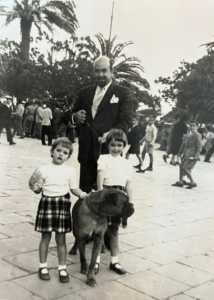
Stanley with Anita and Linda in Las Palmas circa 1956
A lot can be found on Stanley Pavillard online about his early life, his achievements during the war and his career as a doctor. What is less talked about, for obvious reasons, is his private family life. Stanley was a father to three daughters, Linda (my mother), Anita and Sandra. His wife, Irene, an extraordinarily witty and funny lady, remained in his shadow most of her life but shone equally bright in our hearts with her unique style.
Although a proud war hero, Stanley was marked by the war in ways that even I, as a five-year-old grandchild could notice. Due to lack of proper nutrition and vitamins in the camps, Stanley’s eyesight slowly deteriorated over the years to the point where he had very limited tunnel vision. As children, we were always told very strictly to move any toys out of the way or Grandpa might slip on them and fall. Another memory my mum shared with me is that Stanley told his daughters never to touch him while he was asleep. Out of fear of being attacked in his sleep, he had developed a hypervigilance during his time in the POW camps and would jump at any sound or movement. One night, little Linda forgot, touched her sleeping dad and to her surprise got a tight slap!
There were happy and funny memories too, of course, such as the big parties he would throw at the extravagant house he built for the family. I remember my grandfather surrounded by lots of guests and children, doing his favourite trick of hiding his hand in his sleeve and pulling it out suddenly with a loud roar to scare everyone. We couldn’t get enough of his tricks and jokes. Stanley had a sense of drama and a charisma that was hard to ignore. As a child I was both fascinated and terrified when I had a stomach-ache and would finally be brought to him for consultation. He would make me lie down and press his hands carefully against my tummy. The cure felt instant every time.
Stanley marked a generation or maybe even two with his tremendous work in saving so many lives during the war. My mum remembers the countless letters the family would receive at Christmas: Thank you, Pav, for saving my life. The love, generosity and compassion he radiated during those extremely hard times have marked history, together with all his fellow soldiers and prisoners who endured the war. What he left behind, and maybe passed on, is a capacity for adapting and surviving in the hardest situations, thanks to creativity and perseverance, as well as a willingness to move forward and create a life after traumatic events. Equipped with all these skills, our job as his family is to not only survive in a world that is complex in different ways but to thrive and work towards even better times.
Congratulations to Donna Gowland, whose page-turning historical mystery, The Lost Girls, is published today!
The Lost Girls is the second book in the Mary Shelley Investigations series: Gothic murder mysteries with a tenacious literary heroine working as a female sleuth.
After triumphantly solving a murder case in Paris, Mary Wollstonecraft Godwin and Percy Shelly return to London penniless.
As Percy is still married to his estranged wife, he and Mary are shunned from polite society for living together out of wedlock.
Isolated and trapped in squalid lodgings, Mary finds herself alone while Percy escapes to the tavern. But one evening when she goes looking for him, she stumbles upon a body.
She leaves to fetch help and when she returns the dead girl is gone…
When she receives a note from an old friend and discovers another girl is missing, Mary wonders if the crimes are connected.
What happened to the body? Was it taken by the murderer?
Can Mary and Percy come together to solve another tricky case…?
Congratulations to Eric Helm, whose action-packed Vietnam War adventure, Bromhead’s War, is published today!
Bromhead’s War is the thirtieth book in the Vietnam: Ground Zero series: action-packed, authentic historical thrillers set during the Vietnam War.
An Army general, on a recon mission near the Vietnamese/Cambodian border disappears when his aircraft is engaged by anti-aircraft fire.
A search using Air Force and Army assets is hastily set in motion because the general has information about planned critical missions.
Men are deployed from a Special Forces camp commanded by Captain Jonathan Bromhead, and he enlists the help of Major Mack Gerber and Sergeant Major Anthony Fetterman.
But Gerber and Fetterman have been given their own secret mission: to gather intelligence about the build-up of North Vietnamese Army forces just over the border in Cambodia.
And when those forces encroach on the camp, the situation suddenly becomes deadly…
Can they recover the Army general? Will the US missions remain confidential?
Or will enemy forces take over the Special Forces camp…?
Congratulations to
England, 1605

Anne of Denmark, Queen of England, gives birth to her daughter Mary, her first child since coming to England in 1603 when her husband James succeeded to the English throne.
Although they would have preferred a son, both parents are pleased the child is healthy, and their courtiers are thrilled with the birth of the first royal child on English soil in nearly seventy years.
The Scottish family has been welcomed by the English and the reign has started out well, despite continuing tension between the Catholics and the Protestants.
Although Anne has enjoyed the opportunities in England for promoting her artistic interests, she feels inferior to James, and finds satisfaction in rearing her four children, in particular her eldest son Henry.
Anne is determined to bring about an engagement for him with the Spanish infanta. But with anti-Catholic sentiment on the rise, it is not necessarily the wisest match.
Anne becomes pregnant again, but almost immediately afterward the news is clouded by the discovery of the Gunpowder Plot, aimed at the near total destruction of the royal family.
The troubling psychological impact on James is enormous, and Anne worries for the stability of their family.
Can she secure a suitable match for Henry? Will her children survive to adulthood?
Or could the Stuart reign already be doomed to fail…?
Congratulations to David Clensy, whose thrilling war-time naval thriller, For Those In Peril, is published today!
For Those In Peril is the first book in the Romulus Hutchinson Naval Adventure series.
Twin brothers Romulus and Remus Hutchinson grew up in a proud seafaring Liverpool family. So when war breaks out in Europe, they are both keen to sign up and do their part.
With their parents’ consent, both boys join up on their 16th birthday in October 1939 – Romulus as an RNVR sub-lieutenant on a Royal Navy destroyer and his brother as a deck hand with their father’s employer, John Holt & Company.
But with Romulus’s sadistic training officer seemingly intent on breaking the cadets’ spirits before their careers have even set sail, he struggles with the intense training.
There is no time for doubts, however, as the two brothers are quickly thrown into combat.
With Operation Dynamo around the corner, will the Hutchinson brothers both make it out alive…? Can they make their mark as their forefathers did before them?
Or will the bottomless deep claim yet more victims…?
Congratulations to Cara Clayton, whose absorbing historical saga, Mistress of the Manor, is published today!
Mistress of the Manor is the first book in the Tapestry Tales Medieval Saga: English historical fiction set in the fourteenth century.
Clémence Masson has always yearned for more than her expected marriage to an apprentice or farmer’s son.
So when an opportunity arises at the nearby Grimsthorpe Manor House to be a companion to a newly-arrived bride-to-be, Clémence is excited by the opportunity.
The young bride is soon to be handfasted to the lord of the manor, Ruadhán Amundeville, who is recently returned from battles with the Scots.
Ruadhán’s uncle Aedric has been overseeing the estates in the young lord’s absence, and it soon becomes clear to Clémence that Aedric does not have Ruadhán’s best interests at heart.
But Clémence does. She has found herself falling for the charming lord of Grimsthorpe.
When Ruadhán leaves for war with the French, Clémence is left with Emma to deter Aedric’s unwanted advances.
And with the Black Death threatening, all of their lives could be at stake…
Will Clémence achieve her dream of rising above her station? Could Grimsthorpe hold the key to her happiness?
Or will the darkness surrounding the manor destroy everything in its grasp…?
Congratulations to David Mackenzie, whose action-packed military adventure, Defying the Odds, is out now!
Defying the Odds is the second book in the John Noble Fighter Ace Thrillers series.
After fourteen months of flying, John Noble is now a capable and experienced Fighter Pilot.
His squadron has successfully survived the intense period of aerial warfare over Dunkirk, but now new challenges are facing them from the Luftwaffe.
And there is a major issue with their leadership.
415 Squadron’s CO, Wing Commander Christopher Bland has shown that he is clearly not up to the task he’s been given. And if Bland is the one to lead them in the Battle of Britain, John knows the outcome could be disastrous.
But with waves of inbound hostile aircraft relentlessly attacking, there is limited time to raise the issue.
The Battle of Britain is underway and if nothing changes, the outcome for the pilots could be nothing short of a slaughter…
Can the 415s defy the odds, or will this battle be their last…?
Following the success of her many historical and mystery romances, including the Lady Fan Mystery Series and The Governess Trilogy, we are delighted to announce that we will be republishing eight backlist titles by Elizabeth Bailey.
In Elizabeth’s words:
“As a child, I found and read with relish Georgette Heyer’s historical romances. For several years, my parents gave me the latest Heyer as one of my presents at Christmas, thereby ensuring I would bury myself in the book until I finished it. It was inevitable, perhaps, that when I came to write myself, I chose to try my luck with historical romance. It took time, but I was successful at last.
“Of the eight books that Sapere is taking on, almost all feature a hero or heroine disadvantaged in some way. It is an ever-fascinating thing to me how the human spirit manages to overcome all manner of life’s apparent cruelties. Yet these are not necessarily dark tales, although they have their moments. It is the pleasure of writing romance that one’s task is to lead the protagonists through the scary woods and out into the light of happiness.
“I could not have hoped for a better home for these stories than Sapere Books. I’ve worked with them since the publishing house was formed and the editors are both meticulous and sympathetic to the author’s intentions. They are friendly, helpful and supportive. Moreover, Sapere covers are superb! I’m delighted to entrust my books to Sapere’s hands.”
The forthcoming titles are:
A Trace of Memory
A Lady In Name
Friday Dreaming
The Count’s Charade
An Angel’s Touch
The Veiled Bride
The Conqueror’s Dilemma
A Fragile Mask
Find out more about Elizabeth here.
We are thrilled to announce that we have signed the next three books in The Tarnished Crown series by C. F. Dunn.
Set during the Wars of the Roses, the series follows Isobel Fenton — a brave and determined heiress — and the intrigues that surround her.
“I am delighted to continue working with the team at Sapere Books to bring the Wars of the Roses and this tempestuous period in English medieval history to life.
“I take the view that everything that happened in the past resonates down the centuries. The great names in history didn’t exist in isolation, but were part of a rich web that made up as complex a society as any that exists today. It is relationships at every level that enabled society to work, and when these broke down, conflict ensued. And like people throughout time, actions were driven by love and loyalty, fear, feuds and ambition.
“The next three books in The Tarnished Crown series see Isobel and her beloved Robert confront unforeseen twists of fortune, testing their allegiance to the Crown and to each other as England faces challenges from abroad and treachery at home. And when those closest to the throne call upon Robert and Isobel’s support, bonds of friendship and fealty are stretched to breaking point.”
Congratulations to Jeff Jones, whose exciting Roman adventure, Fortress of Steel, is out now!
Fortress of Steel is the first book in the Legion of the Damned Roman Thrillers series.
When the son of his commanding officer is taken prisoner, young centurion Marcus Corvo is tasked with recruiting men from the underbelly of the Empire to rescue him.
Corvo sets about scouring the gladiatorial arenas, prisons and slave markets, for men desperate and tough enough to join him on what is likely to be a suicide mission.
The quest will take them to the eastern fringes of the Empire where the prisoner is being held in Armenia.
Corvo attempts to mould his recruits into a cohesive fighting force, but long before they are ready they are ordered to leave.
In a land where brother fights brother, and where Corvo and his men could easily be mistaken for the enemy or deserters, Corvo must keep his wits about him as they cross hostile land.
Can Corvo keep his wilful legion of men in line? Will they work together to complete the task?
Or will the journey prove too perilous for even the most hardened men of Rome…?
Congratulations to Tony Rea, whose gripping military adventure, Bouncer’s Bomber, is out now!
Bouncer’s Bomber is the fourth book in the Gus Beaumont Aviation Thrillers series.
SOE pilot Gus ‘Bouncer’ Beaumont is beginning to feel the effects of an exhausting war. After making a bad navigational error he is taken off piloting duties and posted as liaison officer to a Free French bomber squadron.
But the pressure on him continues to build.
First there is the moral dilemma of bombing civilians, then the suicide of a comrade. And, to top off everything, he is accused of murdering a fellow RAF officer.
The murder investigation is dropped, but a cloud of suspicion hangs over Gus and the only way to clear his name is by tracking down the real killer.
Can Gus clear his name and mend his reputation? Will he return to fight in the skies?
Or will the stresses of war push him too far…?
Congratulations to R. M. Cullen, whose twisty murder mystery, Death’s Long Shadow, is out now!
Death’s Long Shadow is the second instalment in the Richard Brinsley Sheridan Mystery Series: eighteenth-century crime thrillers set in London at a time of Revolution.
Playwright Richard Brinsley Sheridan’s retreat to the country is interrupted when he stumbles upon a body during a woodland stroll.
The man is identified as Edward Stretton, cousin to Earl Cannock who Sheridan is residing with.
Stretton had a reputation as a scoundrel and seducer and was heavily in debt at the time of his death.
He had been poisoned, and when the Earl’s servants are questioned, unusual evidence puts one man in custody.
But Sheridan is not convinced of his guilt. And one another man is murdered, he suspects there may be a connection.
Can Sheridan uncover the link? Could he save an innocent man from death?
Or will this case prove too complex for this amateur sleuth…?
Congratulations to Simon Michael, whose absorbing courtroom drama, The Fall Guy, is out now!
The Fall Guy is the tenth book in the Charles Holborne Legal Thrillers series.
The Beatles, the Rolling Stones, the Who … Tin Pan Alley is the heart of London’s music scene.
It is also the dark heart of a ruthless business tainted by sex, drugs and corruption.
When a young fan is found dead from a heroin overdose at an American rock star’s accommodation and the band’s manager is charged with her murder, Charles Holborne, barrister, must defend him.
But Holborne is getting married in two weeks, and for some reason DS Sean Sloane, his best man, refuses to speak to him.
Has Sloane been turned? What has a select group of corrupt Met officers known as ‘the Team’ to do with the case?
And is Holborne’s client the unscrupulous venal businessman he is portrayed or is he, perhaps, The Fall Guy?
We are delighted to announce that we have signed a new naval fiction novel set during the Second World War by Anthony Palmiotti.

Anthony Palmiotti
In Anthony’s words:
“When searching for subjects to write about, I look for little-known stories or actions within bigger events that emphasize the strength of character and the contributions made by ordinary people — the individuals that make a difference to the outcome. Invariably, it is the strength of character of the common man or woman that determines the outcome — that makes the difference between winning and losing. It could be a single heroic action or simply a steadfast stubbornness. It might be the will to go on when common sense says this is not a good idea. They are the unknown people who make the seemingly impossible, possible.
“Operation Pedestal was just one convoy in a war that saw hundreds of convoys. Malta was just one island in a sea of islands. What makes these two different is that they faced extreme odds and yet, through a steadfast perseverance, they beat the odds. The citizens of Malta and the common men on the convoys showed an uncommon resolve. They simply did not give up, even when giving up was the smart thing to do.
“My take on Malta during the summer of 1942 and Operation Pedestal is not a history but a novel. A novel allows the writer to get personal. It not only offers the facts, but, hopefully, a feel for what it’s like when ordinary people are asked to do extraordinary things.”
Discover more about Anthony here.
Congratulations to David Field, whose Victorian thriller, The Long Delayed Revenge, is out now!
The Long Delayed Revenge is the tenth instalment in the Esther and Jack Enright Mystery Series – a traditional British detective series set in Victorian London and packed full of suspense.
London, 1899

Jack and Esther Enright, with their four children in tow, have recently moved to a comfortable new home. Esther has settled into her dream job as headmistress of the local private school, owned by her mentor Emily Allsop.
But things are not going so well for Jack. Though he does not mind the commute to his high-ranking desk job at New Scotland Yard, he is disturbed by the level of recent resignations in by uniformed constables in the East End.
Though the police force has always been used to tackling crime in the more impoverished parts of London, a recent influx of Russian immigrants has led to gang warfare and vigilante justice which is proving impossible to control.
And when Esther’s school is vandalised with a disturbing message, he finds his detective skills are needed closer to home as well.
Things escalate when one of the young pupils is abducted and Jack needs all the help he can get in finding the perpetrator before it is too late.
Can Jack and Esther solve another case together? Will they rescue the child in time?
Or will the unrest in London prove too much for even Jack to handle…?
Following the success of The Marwood Family Tudor Saga, we are delighted to announce that we have signed a new Sherlock Holmes-inspired cosy crime series by Amy Licence.
In Amy’s words:
“Tucked away in a sleepy Sussex village, Sherlock Holmes’ great-great niece Charlotte Holmes wants nothing more than to run her antiquarian bookshop in peace and quiet. Divorced, and with her grown-up children having flown the nest, she’s looking forward to reading her way through the shelves, attending quiz nights with best friend Nell, and going out for dinner with handsome lecturer Toby. But then a young woman unexpectedly turns up in answer to an advert she placed for a housemate, whose name just happens to be Scarlet Watson. It seems too much of a coincidence, but when the landlady of the local pub is murdered, the pair team up to solve the crime, and Scarlet’s infectious enthusiasm wins Charlotte over. But is the new arrival all she seems? What secrets is Scarlet hiding?
“A Study in Scarlet is the first book in my new cosy crime series, inspired by the Sherlock Holmes stories. I’ve always loved reading detective fiction and, as an English teacher, I have been reading the Holmes stories with my classes for twenty years. I felt it was a perfect addition to the genre, imagining a modern setting for some familiar devices, swapping the gender of the detective, and keeping a literary twist — my heroine loves reading! Each book is based on one of the original stories and Holmes fans will love spotting the overlap and solving the crime.
“I’m delighted to be branching out with Sapere Books into another genre that I’ve always loved. Books two and three in the series are already planned and ready to be written, with more sleepy village intrigue, plus some local festival glamour, but always remaining true to the Holmes genre.”
Discover more about Amy here.
Congratulations to D. R. Bailey, whose heart-pounding military adventure, The Fire Maidens, is out now!
The Fire Maidens is the third book in the Secret Sirens Aviation Thrillers, set during the Second World War.
Sisters Anna and Jennifer Nightingale have been flying in top missions with the Secret Sirens all-female RAF unit for nearly a year.
Their squadron of twelve Mosquitos stages a raid on Rouen to divert the enemy’s attention from the Lancasters which are coming in to bomb the marshalling yards and port.
But while Jennifer makes it through the mission safely, Anna and her navigator, Maria, are forced to ditch into the Channel.
Luckily they are picked up by a British Destroyer. And on board is none other than Winston Churchill himself.
Impressed by the skill-level and bravery of the female pilots, Churchill is keen to learn more about their training.
He escorts them back to base where they are given a new mission: to attack the Nazi-occupied Mimoyecques Fortress.
The Allies know that the Fortress is being armed with high calibre guns capable of reaching London in a massive, unending bombardment. The Sirens need to drop bombs into the railway tunnel entrance of the Fortress as soon as possible before the unthinkable happens.
But with very little time to train, will the Sirens be able to pull off the task? Can they reach the Fortress unscathed?
Or will these Fire Maidens join the many thousands who have already lost their lives in this brutal war…?
As we celebrate 250 years since the birth of one of England’s most beloved authors, we asked Laura Martin, author of the Jane Austen Investigations series, to tell us what Jane Austen’s work means to her and how it has influenced her own writing.
2025 marks the 250th anniversary of Jane Austen’s birth and is the perfect opportunity to reflect on her literary legacy and the influences that shaped her writing.

The Royal Crescent, Bath
Jane Austen is one of Britain’s most well-known and influential authors. Over two hundred years after her death her books are still immensely popular and there are numerous film and television adaptations, as well as books inspired by her life and her characters. Much has been theorised about the sort of woman she was, a picture built from the letters she wrote to her sister Cassandra as well as other friends and relatives; she has become immortalised by her work and the people who celebrate it.
One reason Jane Austen’s books are so popular is her ability to build complex and layered characters, a reflection of the people we meet in real life. No two characters are the same, and even the minor players are well defined. It allows the characters and their flaws to linger in the reader’s mind — how often have I met someone and thought how similar they are to anxious Mr Woodhouse or foolish Lydia Bennet.
Undoubtedly there were many influences on Jane Austen and her books. Her main themes revolved around marriage, love, class divisions and morality. Her stories often centred on intelligent and spirited heroines — Elizabeth Bennet, Elinor Dashwood, Anne Elliot — who are forced to navigate societal expectations in the pursuit of happiness. Through these characters Jane Austen explored the roles of women in society, economic dependence and social mobility with a clarity and subtlety that remains impressive to this day.

Pulteney Bridge at twilight
Although Jane Austen did not live past the age of forty-one, she led a rich and varied life for a woman of her time. Her early life was spent in rural Hampshire, but in 1801 she moved to the city of Bath — a move that her letters suggest she was not overly happy with. However, there is no doubt that her time spent in the city — a place of genteel society and social ambition — offered her the perfect opportunity to observe human behaviour, which she then used to help form the flawed but interesting characters that we have all come to love.
For an author writing about Jane Austen, Bath is the perfect place to immerse yourself in the Georgian era. The streets are lined with beautiful examples of Georgian architecture and when you stroll around the curve of the Royal Crescent, you can almost imagine you might catch a glimpse of Jane Austen herself.
In my Jane Austen Investigations series I have attempted to capture the essence of Jane as an author and a person, especially her unparalleled insight into human nature. It is always daunting, writing a story where the main character once existed, especially when it is someone universally beloved, but I hoped to celebrate her genius and explore the life of the woman behind the books.
I have no doubt that in another two hundred and fifty years Jane Austen’s books will still be as popular as they are today — her wit and wisdom will still be as compelling as they are now.
Discover more about Laura here.
IN THE JANE AUSTEN INVESTIGATIONS SERIES:
Featured image credit: Photo by Dominika Walczak on Unsplash.
Congratulations to Neil Denby, whose action-packed Roman adventure, Scutarius, is out now!
Scutarius is the fifth book in the Quintus Roman Thrillers series.
In the high Alpen lands, Tiberius, General, Praetor, son of Caesar Augustus, is incensed by the insolence of the native tribesmen who dare to oppose him.
First Spear Centurion Julius Quintus Quirinius and his depleted cohort are posted behind enemy lines to eliminate them. They are to be irregulars, to act as shield-bearer or ‘scutarius’ to Tiberius’ armies, keeping the way before them clear.
If they succeed, Quintus and his men could win back their rightful ranks and stations in the legions. And might even finally be allowed to return to Rome.
But unfamiliar with the rapid turning of the seasons in the mountains, Quintus finds himself trapped by snow and lost in the vast lands of the enemy.
He needs to find a way forward, to do service to Caesar’s sons, but the task seems increasingly impossible.
Can Quintus find his way back to the battle? Could victory in the Alps be in his grasp?
Or will the fickle gods once more betray him…?
Congratulations to Tim Chant, whose thrilling naval adventure Vengeance at the Falklands, is out now!
Vengeance at the Falklands is the fifth book in the Marcus Baxter Naval Thriller Series: action-packed historical adventures following former Royal Navy officer Marcus Baxter during the early 1900s and through the First World War.
Winter, 1914

Lieutenant Marcus Baxter is working in the supply department at HM Dockyard Devonport, when word arrives that the German East Asia Squadron has destroyed a British squadron at the battle of Coronel.
Baxter seizes an opportunity to impress the First Sea Lord, Jackie Fisher, during a snap inspection of the dockyard and secures an appointment to HMS Astute, a scout cruiser, which is being sent to join the squadron in the South Atlantic.
Surviving a storm in the mid-Atlantic, Astute has a run-in with a mysterious passenger liner sailing under the Stars and Stripes, and duels with a German light cruiser stalking the rich hunting grounds off the South American coast.
After an intense engagement, which sees the Astute fleeing along the coast to Montevideo for emergency repairs, Baxter once again encounters the suspicious liner. And this time he is determined not to let it get away.
Baxter risks everything to sneak aboard, and makes a shocking discovery. He needs to reach the safety of the Falklands before any intelligence falls into the wrong hands.
But with the enemy on his tail, the race along the South Atlantic won’t be an easy one…
Congratulations to Donna Gowland, whose absorbing murder mystery, The Missing Wife, is out now!
The Missing Wife is the first book in the Mary Shelley Investigation series.
It isn’t easy being the daughter of the great Mary Wollstonecraft, harder still to navigate life without her. 16-year-old Mary Godwin is desperate for excitement and trapped in a family she feels stifled in, under the watchful, disapproving glare of her stepmother Mary, she is constantly battling for her father’s attention and approval.
So when the young Romantic poet, Percy Shelley, comes blazing into her life, she falls quickly and deeply in love with him. But Percy has plenty of demons. He is already married with a second child on the way, and he turns up to the Godwin family home with a bottle of laudanum, declaring he will end his life if he cannot be with Mary.
William Godwin forbids contact between them, but Mary’s heart aches for the man she believes to be her soulmate. And so she agrees to elope to Paris.
The excitement of the journey soon wears off and they arrive in the city weary, travel-sick and penniless, though luck finally seems to be on their side when they meet a man who offers them money to find his missing wife.
But with Mary becoming increasingly homesick and concerned for her future, will her love affair with Percy be all she had hoped for? Could the search for the missing wife set her on a new course of self-discovery?
Or will her first daring adventure prove to be her downfall…?
Between 1940 and 1944, Donald Macintyre was among the most successful submarine hunters in any Allied navy, transforming the Battle of the Atlantic with his successes against the U-boat menace. To commemorate the eightieth anniversary of the end of World War Two, Donald’s daughter, Dani, shares a personal memory from her father’s life after the conflict.
In 1960, when Dad was employed by MGM as Nautical Advisor on Mutiny on the Bounty starring Marlon Brando and Trevor Howard, he left my mother in charge of the pig farm. I can only suppose that she felt annoyed to be left with this responsibility, because she sold all the pigs and demanded a flight to California!
my mother in charge of the pig farm. I can only suppose that she felt annoyed to be left with this responsibility, because she sold all the pigs and demanded a flight to California!
Dad complied, and I was able to join them for a fascinating holiday, mainly spent in Culver City’s MGM Studios every day. I watched the crew film scenes of a half replica of the Bounty on rollers, with wind and water machines simulating a storm on the high seas. To my joy I also spent time with the crew of Rawhide, a Western TV series. They made a fourteen-year-old girl feel very welcome!
If you have ever watched Mutiny on the Bounty, you might have noticed that in one scene Marlon Brando comes out of his cabin wearing a ridiculous red velvet smoking jacket. When Dad was asked to approve this costume change, he said it would never have been acceptable in those days. Hollywood being Hollywood thought it made handsome Marlon irresistible, so they kept it in. This made Dad wonder what he was being paid for, apart from sitting and playing cards with Gordon Jackson in Tahiti!
Congratulations to
Nineteen-year-old Anne of Denmark, Queen of Scotland, is thrilled and triumphant at the birth of a healthy baby boy, destined to reign as King of Scotland and, possibly, England.
But Anne’s enjoyment of maternal glory quickly fades as her husband King James, fearing his son will be politically manipulated against him as he was against his mother, the deceased Mary Queen of Scots, removes the child permanently from her care.
Outraged, Anne tries to regain control of her son, initiating a bitter marital struggle which sours what had been a loving and harmonious marriage.
Anne is haunted by the giant legacies of Mary Stuart and Elizabeth Tudor on the thrones of Scotland and England, and is determined to make her own mark.
And central to that ambition is securing the succession to the English throne from her husband’s cousin, the elderly and childless Queen Elizabeth.
Can Anne regain favour with the Scottish King? Will they join forces to secure the English throne?
Or will this daring Queen of Scotland fade into obscurity…?
Canadian paratrooper Leo Heaps (1923–1995) was seconded to the British Army during the Second World War and participated in the Battle of Arnhem. He was captured by the Germans and upon his escape, his work with the Dutch Resistance to help rescue hundreds of Allied soldiers behind enemy lines resulted in his being awarded the Royal Military Cross for “outstanding gallantry”. To commemorate the eightieth anniversary of the end of the Second World War, Leo’s son Adrian reflects on his father’s life in 1945.
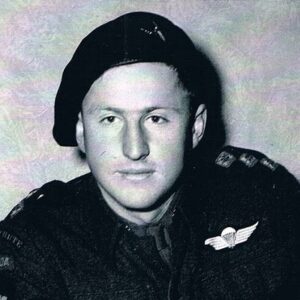
Leo Heaps
In 1945, Leo Heaps was just twenty-two, a young Canadian whose experiences in the Second World War shaped him into the complex figure I knew.
Born in Winnipeg in 1923, growing up as the son of Abraham Albert Heaps, a prominent Parliamentarian, wasn’t easy, but Leo forged his own path. Educated at Queen’s University, the University of California, and McGill, he was restless by 1944, bored with the Canadian Infantry Holding Unit. His commanders underestimated him, calling him “not of officer caliber, no initiative, not aggressive enough.” Sarcastic and defiant, he failed to qualify for the Infantry. His father urged him to work on his aunt’s farm, an exemption from service, but Leo sought action. He volunteered for the CANLOAN program, seconding Canadian officers to the British Army, a choice that plunged him into Operation Market Garden.

Leo (upper right) before his first jump into Arnhem
In September 1944, Leo joined the British 1st Airborne Division, commanding the 1st Parachute Battalion’s Transport — without ever having jumped before. He described his first drop on 17 September 1944 with vivid clarity: “I floated down gently from heaven at 1:30 p.m. on Sunday… The sun shone, the fields of Wolfheze were bathed in warm light and the green meadow bloomed with large bursts of yellow sunflowers.” That beauty was short-lived. The Battle of Arnhem, part of a failed plan to seize Rhine bridges, ended in defeat. Captured by the Germans, Leo didn’t stay a prisoner for long. With the help of the Dutch Resistance, he escaped, hiding in a chicken coop at Ennyshoeve. There, he met members of the Resistance risking their lives for Allied evaders.
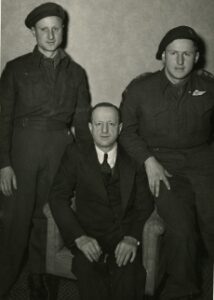
Leo with his father and brother David
His work with the Dutch Resistance earned him the Military Cross, a rare honour for a Canadian in British service. His brother, David, also received the Military Cross, making them the only Jewish brothers during the Second World War to win the decoration. Leo’s role in Operation Pegasus, the escape of over 100 Allied soldiers across the Rhine, was a triumph he chronicled in his book The Grey Goose of Arnhem. He called it “the most amazing mass escape of World War II.”
But some memories were harder to share. In April 1945, Leo was among the first to enter Bergen-Belsen concentration camp after the Germans fled, leaving behind a typhoid outbreak and unimaginable suffering. As a Jewish soldier, the sight of skeletal survivors, the stench of death, and the chaos of the camp struck him profoundly. In Escape from Arnhem (1945) he described the eerie silence broken by the groans of the starving, the piles of unburied bodies, and the desperate eyes of those clinging to life. The scale of the horror overwhelmed him. He rarely spoke of Belsen, but when he did, his voice was subdued. I can picture him there, a young man of twenty-two, confronting a darkness that no one could fully process.

Leo with his father following his decoration
By May 1945, Leo was no longer the kid who frustrated his commanders, but a decorated veteran, a survivor of capture, combat, and collaborator with the Dutch underground. However, the war left its mark on Leo in what we now recognise as PTSD. The loss of friends killed by the Germans ushered a quiet guilt for those surviving when so many didn’t. Yet Leo channelled his unease into action, as if movement could keep the ghosts at bay. His writing, his adventures, his relentless drive — they were, in part, his way of coping with a war that never fully left him.
In 1994, my son and I accompanied Leo to Arnhem for the fiftieth anniversary, as one of forty Canadian veterans. I often wonder what he felt in those sunflower fields, thinking of his lost comrades and his own life’s pursuits. Some of these feelings can be found in his records and letters in the Ontario (Canada) Jewish Archives, which offer a glimpse of the man and the many moments beyond his stories.
Leo died in 1995, leaving a legacy I’m still unravelling. In 1945, he emerged from the war not just as a survivor but as a storyteller who gave voice to the unsung. His books are a testament to a war that left its scars, but also of the man who became my father.
By Leo Heaps:
Keith Panter-Brick joined the Territorial Army in March 1939, at the age of eighteen. When war broke out six months later, he was sent to France, where he was entrenched ahead of the Maginot Line in spring 1940. Following the devastating German blitzkrieg, he was captured in May 1940 and spent the next five years as a prisoner of war. To commemorate the eightieth anniversary of the end of World War Two, Keith’s friend and colleague, Paul Jankowski — Raymond Ginger Professor Emeritus of History at Brandeis University — reflects on Keith’s harrowing wartime memoir, Years Not Wasted, below.
“We were totally outclassed,” Keith Panter-Brick told me in the early 2000s. He was speaking of May 1940, when the German land and air forces overwhelmed the Allied forces in Belgium and northern France. Taken prisoner that month, he spent the next five years — the first half of his twenties — in German prisoner of war camps (Stalags) in occupied Poland. The mental honesty, scrupulous accuracy, and personal humility in his brief comment captured much of the man, the scholar, and the friend I would first meet some fifty years later.
The same qualities would reappear in his memoir, Years Not Wasted. When he returned home to Merseyside, England, in 1945, all he had was his diary, along with the many letters that had somehow reached his family. He would return to them many years later in his memoir, retelling and perhaps reliving the captivity that he and other captured Western soldiers had to endure. They contended with conditions worse than those of the officers, but far better than those of the Soviet and Polish prisoners, most of whom perished in one of the great war crimes of the Second World War. Neither self-pity nor heroics coarsen his narrative. He writes of malnutrition and bitter cold, but also of Red Cross parcels, of boredom but also release, of submission but also resistance and, in his case, attempts at escape — once in 1944 from the camp itself, and again in 1945 from the virtual death-march out of it.
It is a recollection mixing scrupulous honesty with vivid detail, on one level a document about captivity in wartime, on another a spiritual memoir of inner freedom wrested from adversity, before its physical reality was finally restored.
We are thrilled to announce that we have signed the fifth book in The Marwood Family Tudor Saga by Amy Licence.
Set at the court of King Henry VIII, the series follows the drama and intrigue at the heart of the Tudor court.
In Amy’s words:
“I’m really excited to be publishing the next instalment in Thomasin Marwood’s journey with Sapere Books. Readers of the series will recall her turbulent experiences at the court of Henry VIII in the 1520s. The young Thomasin arrived aged seventeen, fresh from her Suffolk childhood, to navigate the various intrigues and romances of court life. She is dazzled by the elegance of Anne Boleyn, before she finds a place in the household of Catherine of Aragon. Watching the royal marriage unravel, Thomasin becomes close to her mistress, who trusts her implicitly, whilst trying to protect her own heart from the handsome Rafe Danvers and other suitors.
“Now, two years later, the eagerly anticipated Legatine Court is about to open at Blackfriars, to test the validity of Henry and Catherine’s marriage and hopefully bring them all some resolution. Not all is as straightforward as it seems, though, as friends and lovers just as quickly turn into enemies, and long-term scandals in the Marwood family threaten to re-surface. Then there is Thomas Cromwell, keen to do Henry’s bidding, leading to some dangerous clashes with Thomasin’s father.
“I love writing the Marwood series, with all the colour, textures and details of life at the Tudor court. It’s the closest we can come to travelling back in time there ourselves. When I was planning this series, I wanted to create a heroine outside the cast of usual characters, a complete outsider with whom the reader could identify, and set her within the dynamic of known individuals like Anne Boleyn and Catherine of Aragon. There must have been many similar silent witnesses to the crucial events of the 1520s who have gone unnamed and unrecorded, so Thomasin also represents them.
“There’ll be some twists and turns in this book, but it’s building towards a mid-series mini-conclusion, with both Thomasin and her cousin Ellen settled by the end. I thought it time to give them both some happiness at last, after everything they’ve been through. After that, I hope to give Thomasin a little breathing space, then bring her back to court in 1532, for Book Six. She will find herself at Anne’s side through the coming years, as a witness to her queenship and downfall.”
To keep up to date with Amy’s latest releases, visit her website.
The Marwood Family Tudor Saga:
Group Captain Bobby Oxspring, author of Spitfire Command, saw action in many of the most famous battles of the Second World War, including Dunkirk and the Battle of Britain. To commemorate the eightieth anniversary of the end of World War Two, his great-grandson, Daniel, shares his reflections on Bobby’s life below.
Flying ace Robert (Bobby) Wardlow Oxspring held the rank of squadron leader when World War Two ended in May 1945. Throughout April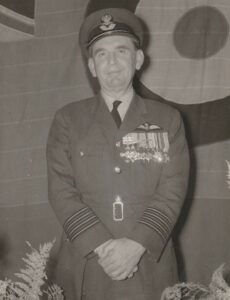 1945, he was confident that the war was soon to conclude. His mood on VE Day as an optimistic family man would have no doubt been a mixture of pride and reflection. He would have been proud of his achievements: he’d been made leader of the 141 Wing at Deanland only the year before, and had been awarded a Distinguished Flying Cross and Two Bars as a flying ace. He would have been reflecting on his numerous wartime adventures, from the Battle of Britain to his time in North Africa, Italy and many other countries. Bobby’s mood on VE Day likely matched the mood of many of ‘The Few’, and I have no doubt he would have felt joy at the war’s conclusion.
1945, he was confident that the war was soon to conclude. His mood on VE Day as an optimistic family man would have no doubt been a mixture of pride and reflection. He would have been proud of his achievements: he’d been made leader of the 141 Wing at Deanland only the year before, and had been awarded a Distinguished Flying Cross and Two Bars as a flying ace. He would have been reflecting on his numerous wartime adventures, from the Battle of Britain to his time in North Africa, Italy and many other countries. Bobby’s mood on VE Day likely matched the mood of many of ‘The Few’, and I have no doubt he would have felt joy at the war’s conclusion.
For me, the great-grandson of Bobby Oxspring, my great-grandfather has had a huge influence on my life — not only as a proud figure to look up to, exemplifying courage and bravery, but also through his stories. His career after VE Day did not lose momentum. He received a permanent commission as a flight lieutenant on 1st September 1945 and was promoted further to substantive squadron leader on 1st August 1947. One incredible achievement, however, was his award of an Air Force Cross. This was for leading number 54 Squadron of the RAF Vampires to Canada and the US, the very first jet aircraft to cross the Atlantic.
After VE Day, he never stopped being admirable. He undertook further tours, even across Italy, and eventually became Station Commander of RAF Gatow in Berlin. At Churchill’s funeral, he walked at the very front.
I have been to RAF Cranwell to see some of my great-grandfather’s personal scrapbooks and was even fortunate enough to sit in the cockpit of his recovered plane in the Dumfries and Galloway Museum in Scotland. These are only a few of the moments I have taken to reflect on his life.
On VE Day I am almost certain that one thought would have prevailed in his mind: his admiration and respect for the mighty Spitfire, and his pride at having flown it.
Keith Panter-Brick joined the Territorial Army in March 1939, at the age of eighteen. When war broke out six months later, he was sent to France, where he was entrenched ahead of the Maginot Line in spring 1940. Following the devastating German blitzkrieg, he was captured in May 1940 and spent the next five years as a prisoner of war. To commemorate the eightieth anniversary of the end of World War Two, Keith’s daughter Catherine — Professor of Anthropology, Health, and Global Affairs at Yale University — shares her memories of her father below.
“Each day life is hanging in the balance.” That was the phrase with which my father ended his book, Years Not Wasted. I think that everyone with a lived experience of war will understand that sentence: the notion that you may or may not live, may or may not be free, may or may not return.
Keith Panter-Brick was a prisoner of war in Poland from 1940 to 1945. He was captured at Isières when he was just nineteen. Under the Geneva Convention, ordinary soldiers were obliged to work — and were put to hard labour in POW camps. If he ever survived the cold, hunger, exhaustion, and brutality of war, Keith promised himself that he would study philosophy and go to university, the first of his family to do so. Admitted to Keble College, Oxford, he joined a postwar student delegation to Heidelberg for cultural exchange and reconciliation. There he met my mother, a student from Alsace-Lorraine on a French delegation to Heidelberg. The two fell in love — my father courted in German, their only common language at the time — and in that short week, they decided to marry. They built a family, rooted in the practice of non-violence and cross-cultural understanding.
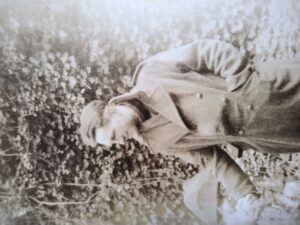 My father’s book began decades later, assembled from scraps of his diary, postcards, and letters sent through the Red Cross, all of which he had kept hidden away in a shoebox. On page seven of the first edition, you’ll find his death certificate — the Office of the Cheshire Regiment officially reported him killed in action in May 1940. It took months for news of his survival to reach home. That certificate became for me the most vivid proof that life indeed is hanging in the balance.
My father’s book began decades later, assembled from scraps of his diary, postcards, and letters sent through the Red Cross, all of which he had kept hidden away in a shoebox. On page seven of the first edition, you’ll find his death certificate — the Office of the Cheshire Regiment officially reported him killed in action in May 1940. It took months for news of his survival to reach home. That certificate became for me the most vivid proof that life indeed is hanging in the balance.
Years Not Wasted isn’t a grand officer’s tale. It’s a soldier’s story, grounded in hard labour, frostbitten marches, and everyday endurance. Because he learnt passable German, Keith was once included in an escape attempt with RAF officers, only to be recaptured in Gdansk, at the dockside when attempting to board a Swedish vessel. He survived the Great March out of Poland in the most brutal of winters, thanks to a pair of good boots made in his father’s bootmaker shop. Even years later, my sister Brigitte, now a regular walker in the forests of Lorraine, measures distances in fractions of “Great March kilometres.” In my own teaching and research, I focus on the biological and social signatures of war across generations, and on pathways to peace. My son Jannik chose to study POW trade and barter systems for his Masters’ dissertation at Cambridge. Each of us carries a trace of my father’s war experience.
My father was impetuous. Once, while we were travelling from Nigeria to Cameroon, he filmed a bull elephant that decided to charge us on a dusty road. He stood in front of the car with the hand-held camera, while we huddled in the back. He once flagged down the pilot of a plane by running onto the runway, not wanting to miss his actual flight. But he became, over the years, immensely patient. Whilst a professor at the London School of Economics, he turned to gardening, building stone walls, and restructuring the house we purchased in Lorraine — a house that still has “2 OFF” (“must house two German officers”) carved in the front doorway. My father taught me to value ordinary things in everyday life: raking leaves, washing dishes, being attentive to other people. He never forgot what it meant to be hungry. He told me that being alive is a gift from God, and that good health is a blessing one can only really understand after one has lost it.
 In 2025, we republished Years Not Wasted. It’s more than a memoir — it’s a witness statement. It honours ordinary soldiers who endured extraordinary hardship. It is a uniquely authentic book, told in the way it was recorded in letters and a diary at the time, rather than reconstructed from fallible memory. It was written to share the knowledge “soon acquired once war has started that the cost, in lives, in grief, in suffering, is immeasurable, and unacceptable however much one did accept it at the time.” It’s a call to remember how people like my father built their lives after war, choosing patience over bitterness, solidarity over division, peace over conflict. For my father, it was always about taking one step at a time, drawing from patience and reflection. That is the lesson I carry forward.
In 2025, we republished Years Not Wasted. It’s more than a memoir — it’s a witness statement. It honours ordinary soldiers who endured extraordinary hardship. It is a uniquely authentic book, told in the way it was recorded in letters and a diary at the time, rather than reconstructed from fallible memory. It was written to share the knowledge “soon acquired once war has started that the cost, in lives, in grief, in suffering, is immeasurable, and unacceptable however much one did accept it at the time.” It’s a call to remember how people like my father built their lives after war, choosing patience over bitterness, solidarity over division, peace over conflict. For my father, it was always about taking one step at a time, drawing from patience and reflection. That is the lesson I carry forward.
Air Commodore Roderick Chisholm, CBE, DSO, DFC & Bar (1911–1994), author of Cover of Darkness, was a night fighter pilot, flying ace and a highly decorated British airman of the Second World War. To commemorate the eightieth anniversary of the end of the Second World War, his son Julian reflects on his father’s life in 1945.
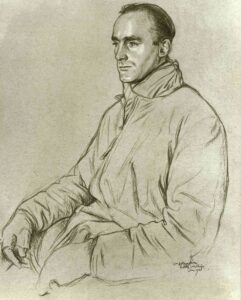
Roderick Aeneas Chisholm by Sir William Rothenstein. Image used with permission from Museums Sheffield
In 1930 Roderick Chisholm joined 604 Squadron of the Royal Auxiliary Air Force. He learnt to fly and was commissioned as an officer. He left the squadron in 1935 when his work took him to Iran. Before rejoining his squadron in late June 1940, he took a refresher course to become a night fighter pilot and fly the squadron’s Blenheims. During the war, while flying Beaufighters and Mosquitos, he shot down nine enemy aircraft with the assistance of his airborne observers and the ground controllers, he commanded the Night Fighter Interception Unit at Ford, and was the second-in-command of Bomber Command’s 100 Group, which was charged with defending RAF bombers over enemy territory. He recorded his wartime experiences in Cover of Darkness, which was first published in 1953.
Immediately after hostilities ended, Roderick led a team of twelve charged with gaining as much intelligence as possible about the impact of 100 Group’s radar-assisted night fighters, Mosquitos, and Radio Counter Measures. The team did their work at the final base of the Luftwaffe in Schleswig, just before it was disbanded and its personnel transferred to POW camps. They carried out interrogations of Luftwaffe night fighter commanders and pilots, observers, flight controllers and technicians, held technical discussions, and examined the vast number of German aircraft parked on the airfields. The team gained confirmation of the effectiveness of 100 Group’s efforts, and had the satisfaction that as a result RAF losses were significantly reduced. The Mosquito had an awesome reputation amongst the German airmen.
 Major Schnauffer was one of the pilots whose interrogation Roderick witnessed. Schnauffer was a brave and skilful night fighter pilot who was credited with shooting down no less than 124 bombers in defence of his country. He wore uniform, and on the last day the Germans were allowed to wear medals, he wore the highest order of the Iron Cross around his neck. The exchanges with the Germans were generally civilised and friendly, but my father could not ignore that they were Nazis, and that nearby were camps for Russian prisoners living in ghastly conditions, and mini-Belsens for Jews and other displaced persons.
Major Schnauffer was one of the pilots whose interrogation Roderick witnessed. Schnauffer was a brave and skilful night fighter pilot who was credited with shooting down no less than 124 bombers in defence of his country. He wore uniform, and on the last day the Germans were allowed to wear medals, he wore the highest order of the Iron Cross around his neck. The exchanges with the Germans were generally civilised and friendly, but my father could not ignore that they were Nazis, and that nearby were camps for Russian prisoners living in ghastly conditions, and mini-Belsens for Jews and other displaced persons.
Roderick’s mission complete, he flew back to Norfolk. While doing so, he envisioned a future Europe in which frontiers would mean no more and individual nationalities were less important, as per the multi-national squadrons of the Battle of Britain. After the collapse of France in 1940, British, French, Belgian, Czech, Polish and other nationalities had flown in harmony in polyglot fighter squadrons. Their aims were identical, and their understanding effective thanks to the basic English of the radio. Sadly, later, as national squadrons were formed, national identities asserted themselves and the unity achieved in the Battle of Britain became compromised.
In September 1939 the twenty-year-old John Wooldridge, then a Sergeant Pilot, took part in the British air raid on Kiel, the first raid of World War Two. Having brought his damaged aircraft home safely, he was awarded the Distinguished Flying Medal. Commissioned in August 1940, he rapidly rose to the rank of Flight Commander, flying Lancasters as a Flight Lieutenant. In the middle of 1942, for his part in the 1,000-bomber raid on Cologne, he was awarded the Distinguished Flying Cross. By the end of the War, he had flown 97 missions over enemy territory. To commemorate the eightieth anniversary of the end of World War Two, John’s daughter and son, Susan and Hugh, share their memories of him below.
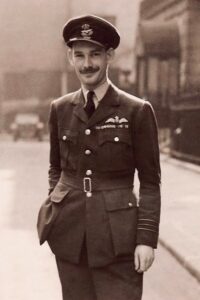
John Wooldridge
On 9th and 10th May 1944, our father, Wing Commander John Wooldridge DSO, DFC*, DFM, returning from New York where his music was being performed at Carnegie Hall, flew over the Atlantic in a Mosquito, taking off from Goose Bay, Canada and landing six and a half hours later in Ballykelly, Northern Ireland. In so doing, he broke the then speed record for crossing the Atlantic.
The Air Ministry, unsure what to do with this daring twenty-five-year-old, told him to lie low but, within a couple of days, they’d been outflanked by the Press and the story was all over the newspapers. As our father writes in his diary for Sunday 14th May: Ye gods, what a splash! Headlines, pictures…
Meanwhile, on Monday 15th May in a London hairdresser, our mother, the distinguished British actress Margaretta Scott, was having her hair done. Whilst under the dryer, she read the story in the London Evening Standard of this amazing trans-Atlantic flight. But what really caught her eye was that the pilot was also a composer of serious music, who had composed a work for Narrator and Orchestra called The Constellations.
‘That’s my boy!’ she cried, as Sir Henry Wood had recently asked her to find a new work for Narrator and Orchestra for his upcoming Promenade Concerts, and she felt that The Constellations might be just the job.
Our mother immediately approached the Air Ministry, but they refused to give out the personal details of the record-breaking flyer.
The story would have ended there if, a couple of days later, at Denham Film Studios where she was making the film Fanny by Gaslight, our mother had not given a lift to a film publicist who, on their journey back to London, had boasted that he’d just been given a camembert cheese flown across the Atlantic by a friend, one John Wooldridge.
‘Bring him to tea!’ she cried. And the next Sunday, there was our father on her doorstep — and that was it! For the next fourteen years until our father’s sudden death in a car crash in 1958, our mother and father were as inseparable as their young family and busy work schedules would allow.
In the 1950s, Margaretta Scott continued to star in plays and films whilst John Wooldridge wrote his music and plays and films. One of his most important films was the 1953 film starring Dirk Bogarde, Appointment in London, about a Royal Air Force Bomber Command squadron, for which he wrote both the screenplay and the music score. To this day it continues to be screened to great acclaim and serves as a memorial to Bomber Command by one of their own.
By John Wooldridge:
Major-General Hubert Essame, CBE, DSO, MC (1896–1976) was a British Army officer who fought in the First and Second World Wars. Following his retirement from the army, Hubert lectured in military history at King’s College London, and published several books and articles. He was also an advisor to television producers for military programmes. To commemorate the eightieth anniversary of the end of the Second World War, his granddaughter Antonia shares her memories of him below.
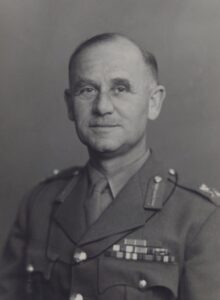
Hubert Essame
Brigadier, later Major-General, Hubert Essame led 214 Independent Infantry Brigade, part of 43rd Wessex Division, in the capture of Mont Pincon, the key to Normandy, as well as of Hill 112, the successful yet most costly single battalion action of the Overlord campaign.
He was a sharp-witted and determined man remembered by the actor and raconteur Dirk Bogarde, his one-time liaison officer, for his “brilliant blue eyes and tongue like a whip”. He had a caustic sense of humour and was a formidable leader from the front.
Soon after the war, Hubert wrote the Division’s official history, The 43rd Wessex Division at War, 1944-45, and later Battle for Normandy, Normandy Bridgehead, The Battle for Germany, and a biography of General Patton. His perspective as a leader of troops into battle, alongside his use of a wide-ranging variety of sources as a historian, makes for a great read even for those who know about Operation Overlord.
His 214 Independent Infantry Brigade, which together with 129 and 130 Brigade and their supporting arms formed Major General Ivor Thomas’s 43rd Wessex Division, were in turn part of the XXX Corps commanded by Lieutenant-General Sir Brian Horrocks all the way from Normandy to Bremerhaven.
The Wessex Division story spans the stormy Overlord crossing and later the crucial Battle for Hill 112. This point south-west of Caen was defined by Eberbach, commander of Panzer Group West, as the “pivotal point of the whole position” and it saw the first of the grim battles of attrition immediately following Caen’s fall. The battle involved heavy casualties and tested the 43rd Division against some of the most seasoned German divisions, well dug in and skilfully hidden.
Road and rail lines lay at right angles to the direction of advance. The bocage of tiny, often boggy fields with sunken lanes and thick hedges reduced visibility for artillery and impeded all movement. And it was high summer. Hubert describes vividly how he crawled forward in the August heat to assess Mont Pincon’s southern slopes before its eventual capture by the Division and 8th Armoured Brigade.
Hubert was a writer whose extraordinarily immediate account includes, for example, the information he gained from German prisoners, subsequent revelations about Hitler’s orders to his generals, and his own point of view at the head of 214 Brigade. His perspective sheds light on some of the huge challenges of the campaign, such as that of establishing a key bridgehead over the Seine at Vernon despite the civilian population’s determination to celebrate as though the campaign was already won.
 214 Brigade fought on through northern France and the Netherlands, including Operation Market Garden, and were among the first Allied troops to enter Germany. They played a key part in the turning of the tide in the Reichswald. I am proud that ‘Brigadier Twinkletoes’ was my grandfather and attempt to read across from his high standards of resolve and determination to the greyer demands of the here and now.
214 Brigade fought on through northern France and the Netherlands, including Operation Market Garden, and were among the first Allied troops to enter Germany. They played a key part in the turning of the tide in the Reichswald. I am proud that ‘Brigadier Twinkletoes’ was my grandfather and attempt to read across from his high standards of resolve and determination to the greyer demands of the here and now.
By Hubert Essame:




















